

 Why Turkey? Hospitality, history and a hot line to the sun. Check your Midnight Express stereotypes at the door - Turkey is a rapidly modernizing country with one foot in Europe and one in the Middle East. It's not all oriental splendour, mystery, intrigue and whirling dervishes but it is a spicy maelstrom of history knocking up against a pacy present. The Turkish people have an unrivalled reputation for hospitality, the cuisine is to die for, the coastline is a dream, and many Turkish cities are dotted with spectacular mosques and castles. And while costs are rising, Turkey remains one of the Mediterranean's bargain-basement destinations.
Why Turkey? Hospitality, history and a hot line to the sun. Check your Midnight Express stereotypes at the door - Turkey is a rapidly modernizing country with one foot in Europe and one in the Middle East. It's not all oriental splendour, mystery, intrigue and whirling dervishes but it is a spicy maelstrom of history knocking up against a pacy present. The Turkish people have an unrivalled reputation for hospitality, the cuisine is to die for, the coastline is a dream, and many Turkish cities are dotted with spectacular mosques and castles. And while costs are rising, Turkey remains one of the Mediterranean's bargain-basement destinations.Post Trip Summary

I spent 14 wonderful days traveling through Turkey. This was my second trip with Gate1Travel. They continue to satisfy my needs with well-planned, well-paced tours and excellent tour guides. Turkey was always on my list of places to visit. I regret not coming sooner because the history, culture, people and geography are among the most stimulating and interesting I've ever encountered in all my travels. It was well worth the visit and there was never a dull moment.
 I was once again joined by my friends Vicki Fowlkes and Vicky Harsch from Arkansas. We met while traveling in Egypt in November 2003. This is our sixth time traveling together. We also welcomed Dave Marlo to our little travel group. We met Dave on our Thailand/Cambodia trip back in January 2007. And Vicky's cousin, Debbie McCalister from Oklahoma, was also a welcome addition to our group. As usual, we were part of a larger travel group comprised of 31 adventuresome Americans from a number of states, with quite a few from Wisconsin and Michigan.
I was once again joined by my friends Vicki Fowlkes and Vicky Harsch from Arkansas. We met while traveling in Egypt in November 2003. This is our sixth time traveling together. We also welcomed Dave Marlo to our little travel group. We met Dave on our Thailand/Cambodia trip back in January 2007. And Vicky's cousin, Debbie McCalister from Oklahoma, was also a welcome addition to our group. As usual, we were part of a larger travel group comprised of 31 adventuresome Americans from a number of states, with quite a few from Wisconsin and Michigan.Itinerary. Our trip lasted 14 days and covered 2,200 miles--all by bus. Our route took us in a large counterclockwise circle covering roughly the western half of the country. We started in Istanbul in the far north. We spent our first night there before making our way to Canakkale for a one-night stay, stopping in Gallipoli and Troy along the way. We then turned south for Izmir on the western coast for a two-night stay, stopping in Pergamum along the way. While in Izmir, we spent a day in Ephesus. After Izmir, we headed southeast to the Mediterranean coast and Antalya for a two-night stay, stopping in Pamukkale en route. While in Antalya, we made a day trip to Perge and Aspendos. After Antalya, we headed northeast to Nevsehir in the Cappadocia region in the middle of the country. We stopped in Konya and Aksaray on our way. We spent two days in Nevsehir, then headed northwest to Ankara for an overnight stay before driving to Istanbul for the last three days of the trip. To get to Turkey, I flew from Milwaukee to New York City (1-1/2 hours), then caught a flight to Istanbul via Amsterdam (New York to Amsterdam: 6 hours, Amsterdam to Istanbul: 3-1/2 hours). On the way home I traveled from Istanbul to Paris (3-3/4 hours, then Paris to New York (7 hours).
Accommodations. We stayed in a number of first class hotels and resorts along the way. Most were located in the heart of the towns we stayed in, or pretty close by.
Food. The food was pretty good throughout the country. For lunch and dinner, we ate a lot of bread, meats (beef, chicken and lamb), vegetables and fruits. We also drank a lot of the local Efes Beer. Breakfasts were always at the hotel and were just so-so. They had the typical European breakfast offerings like breads, yogurt, cereal, sandwich meats, jams, vegetables, fruit and cheese. For us Americans, they had mostly hard boiled eggs, tomato slices with melted cheese on them, and cut up hot dogs in barbecue sauce. The one thing I liked was that the tap water was safe to drink. I also gained an appreciation for Turkish pizza.
Program Directors. Our Program Director, Mr. Salih Gök, made this one memorable trip. The man is a walking encyclopedia--an 11 on a scale of 1-10, and a great ambassador for Turkey. He objectively imparted a tremendous amount of knowledge about his country --its history, people, customs, and place in the world. I now really, truly understand what it means when people refer to Turkey as the "Cradle of Civilization" and the "Crossroads of Civilization."
Tour Group. The tour group was American—all 31 of us. I’d say the average age was about 55, with a fairly even mix of men and women from all parts of the country--including 8 Wisconsinites. You never know what you’re going to get when you travel with a tour group. You always meet the nicest people—and this was no exception. For once we did not have any “head cases.”
Safety Concerns. The Turkish people we met were very friendly and I never felt uncomfortable around them or unsafe at any time, in spite of being an American in a Muslim country. At times, you would hardly even know you were in a Muslim country except for the calls to prayer over loudspeakers several times a day and the occasional woman in a headscarf or burka. The merchants were especially eager to sell us an incredible variety of handmade locals crafts--pottery, rugs, textiles and assorted trinkets. Their English was fairly good, but in general, it was tough to find anyone who spoke English well.
Money and Prices. We only had to deal with one currency--Turkish Lira. Prices were pretty steep due in large part to the weakness of the dollar ($1 USD = 1.20 TRY). I didn't think anything was really a bargain except for the occasional meal or souvenir. At the bazaars, you have to bargain price on everything and the merchants always started out with very high prices. We were definitely at a disadvantage. We grew accustomed to the $6 beers.
What Did This Gate1 Vacation Cost Me? I spent $3,400 on this trip. The base trip was about $1,800, including hotels, transatlantic flights, meals, some tours and trip insurance. I paid another $300 for almost all of the optional trips offered. I also paid $475 for my Milwaukee-New York flight, including one night in a New York hotel on the way home and ground transportation. I spent the remaining $825 on the ground in Turkey: $335 for lunches and dinners not included in the price of the trip, $240 for sightseeing (mostly a hot air balloon ride in Cappadocia), $155 on tips, and $95 on souvenirs and miscellaneous expenses.
In Closing. Travel is an adventure. It’s an opportunity to experience, learn and appreciate how people around the world live. While I’m always happy to come home at the end, I never come back the same person. And for that, I have a lot to be thankful for.
What follows is a day-by-day account of our trip. Each day starts with an overview of what we did, followed by my daily journal highlighting our experience. Enjoy!
Pre-Trip Posts
- September 12, 2007 - For several weeks now, I have been anxiously awaiting this trip to Turkey. In just a few weeks, October 4, we will all be in Turkey--Vicki, Vicky, Debbie, Dave and I. I got my visa ahead of time, so that is one less thing to worry about. I mailed my application and passport from Milwaukee to the Turkish Consulate in Chicago on August 14, and got it back two days later on August 16. Great turnaround. The experience of receiving my travel documents in the mail from Gate1Travel was not as pleasant. Since we all signed up for this trip separately, they were not aware that we were traveling together. This has not been a problem with any of our past travels with this Gate1 since they tend to run smaller groups with one bus and one hotel. Unfortunately, this is one of their more popular trips, so they have more than one bus and are using multiple hotels. This is a problem because when we compared our hotel assignments, I ended up at different hotels in Istanbul, Canakkale and Ankara than Vicki, Vicky, Debbie and Dave. Gate1 says there is nothing they can do about it because all assignments have been made and travel documents have already been sent out to the rest of our travel group. They said they would at least try to make sure we are on the same bus and have the same program director on the trip so we are not separated during the day. The hotel situation is really the only problem in Istanbul since we are there several nights and Vicki, Vicky, Dave and Debbie's hotel is quite a distance from my hotel. The situation in Canakkale is not so bad since it is just for one night and I can take a cab or walk to their hotel. The hotels in Ankara are also right next to one another, so again, not a problem.
- September 23, 2007 - I attended a singles event on Friday at the only Turkish Restaurant in Milwaukee. It was called Tulip, and is only a few blocks from my house. We stayed for dinner afterwards. The menu was in Turkish, so I learned a few new words. The food was delicious, especially the meat dishes. The owners are Turkish, so I'm thinking this is what I can expect in a few weeks. By the way, Tulips come from Turkey. The Dutch imported and improved them, so now get all the credit.
- September 25, 2007 - Got this nice letter from Gate1 confirming that all of my friends and I will be traveling together on the same bus. It doesn't say whether we'll all be staying in the same hotel:
Dear Christopher,
Please be advised that we have been able to get everybody on the reservations below on the same bus for your 14 Day Turkish Treasures tour:
200### - David Marlo
200### - Vicki Fowles, Vicky Harsch, Debbie McCalister
200### - Christopher Trost
Please let us know if you have any further questions.
Ciara Owens, Gate 1 Travel - October 02, 2007 - I leave for Turkey day after tomorrow. I checked the weather over there. It's forecasted to be in the low 70s and sunny for the next several days. Istanbul is the same latitude as Chicago. I was talking to a friend at work who was there a few years ago. We were talking about visiting Troy (Trojan Horse fame) and Ephesus--where St. Paul lived and where the Virgin Mary is said to have died. We also talked about how people with blue eyes are feared. I'll have to wear my sunglasses a lot. But I read that the culture is quite mixed in the more densely populated areas so it won't be uncommon to see some Turks with blond hair and blue eyes.
I found these Interesting Facts about Turkey on the web.- The famous Trojan Wars took place in Western Turkey, around the site where the Trojan horse rests today.
- The first church built by man (St. Peter’s Church) is in Antioch (Antakya), Turkey.
- The oldest known human settlement is in Catalhoyuk, Turkey (7th Millenium B.C.)
- Ephesus and Halicarnasus (the place for the two of the Seven Wonders of the ancient world) are in Turkey.
- St. Nicholas, also known as Santa Claus, was born in Demre, on Turkey’s Mediterranean Coast.
- Noah’s Ark landed on Mount Ararat (Agri Dagi) in Eastern Turkey.
- The last meal on Noah’s Ark, a pudding of sweet and sour taste (asure), is still served throughout Turkey.
- Turks introduced coffee to Europe.
- Turks gave the Dutch their famous tulips.
- Istanbul is the only city in the world built on two continents.
- Tradition in Turkey says that a stranger at one’s doorstep is considered "God’s guest" for at least three days.
- Turkey is noted for having one of the three most famous and distinctive traditional cuisines in the world.
- The first Ecumenical Council was held in Iznik, Turkey.
- Writing was first used by people in ancient Anatolia. The first clay tablets in the ruins of Assyrian Karum (Merchant Colony) date back to 1950 B.C.
- The oldest tin mine was found in Göltepe, 60 miles south of Tarsus.
- The first Neolithic paintings found on man-made walls are in Catalhöyük, Turkey.
- Anatolia is the birthplace of historic legends, such as Homer (The poet), King Midas, Herodotus (the father of history), and St. Paul the Apostle.
- Julius Caesar proclaimed his celebrated words, "Veni, Vidi, Vici (I came, I saw, I conquered)" in Turkey when he defeated the Pontus, a formidable kingdom in the Black Sea region of Turkey.
- Female goddesses like Cybele dominated the Central Anatolian pantheon for thousands of years before these supernatural powers were transformed to male gods.
- The Hittites sold Abraham the cave where he buried his wife Sarah, when the Israelites came to Palestine.
- The first church dedicated to Virgin Mary is in Ephesus.
- Cherry was first introduced to Europe from Giresun (Northern Turkey)
- Turkey has hundreds beaches and marinas which have the "Blue Flag" (an European award for the best clean water) on the Mediterranean and Aegean.
- The first recorded international treaty in the world was the Treaty of Kadesh between the Hittite and Egyptian Empires, Hattusilis III and Ramses II, in c.1275 BC.
- The oldest known shipwreck on Earth was found and excavated in Uluburun near Kas, in the Mediterranean region of Turkey.
- In 640 BC, for the first time in history, coins made of electrum were used by the Lydian king Croesus in Sardis, in Aegean region of Turkey.
- King Midas lived in Gordion, capital of Phrigia.
- Alexander the Great cut the Gordian knot near Ankara. The double knotting technique used in Turkish rugs is also called as Gordian Knot.
- The Garden of Eden in the Book of Genesis was said to be watered by a river which separated into four streams as it left the garden; two of them the Tigris (Dicle) and Euphrates (Firat) rise from the mountains of Eastern Turkey.
- Early Christians escaping from Roman persecutions found shelter in Cappadocia.
- The Seven Churches of Apocalypse are all situated in the Aegean region of Anatolia; Ephesus, Smyrna (Izmir), Pergamum, Thyatira (Nazilli), Sardis, Philadelphia (Alasehir) and Laodicea.
- Sultan Beyazit II dispatched the Ottoman Navy to bring the Jewish people who were expelled from Spain in 1492 and they were brought safely to the Ottoman lands.
- Istanbul has the historical building of Sirkeci Train Station. This was the last stop of the Simplon-Orient Express - "kings of trains and train of kings" - between Paris and Constantinople (Istanbul) from 1883 to 1977. Agatha Christie was one of the pa
- The number of species of flowers in Turkey is approximately 9,000, of which 3,000 are endemic. In Europe for instance there are 11,500 species. This shows the richness of flora and fauna in Anatolia.
- October 03, 2007 - Gawd! I had to work till 8:30 pm then rush home and pack. That took about 1-1/2 hours. I laid out everything I thought I would need then put half of it back. My feet are sore so I was thinking of bringing my roller bag instead of a duffel bag. But I was so squeezed for space that I ended up using my duffel bag instead. I'll just tough it out. I've also got my canvas briefcase with my laptop computer, my cell phone, my pocket organizer and my carry-on items. I need my laptop this trip since I don't want to spend hours when I get home typing my diary. I'll do a little typing every day--maybe. Having a laptop will also allow me to download pictures from my camera and burn CDs for my travel companions to take home with them. I've got a 7:40 am flight tomorrow, so I have a cab coming around 6:00 am to take me to the airport. I'll meet one of our travel group members, Dave Marlo from St. Louis, in New York at LaGuardia Airport. We have a 6 hour layover, so will maybe go into Manhattan for a few hours before heading over to JFK for our evening flight on Northwest/KLM Airlines to Amsterdam, with continuation to Istanbul. The rest of the group, Vicki, Vicky and Debbie are flying United from Chicago to Munich, with continuation to Istanbul. We arrive Friday afternoon around 4:30 pm in Istanbul. I hope to sleep a lot on the flight so I won't be totally drained when we arrive.
Day 1 - Thursday, October 04, 2007 - Travel from USA to Turkey
Itinerary - Depart USA to Turkey. Your flight includes meals, drinks and in-flight entertainment for your journey.
Diary:
 5:00 a.m. US Central Time - Well, I didn't get as much sleep last night as planned. I woke up at 4:30 am, showered and had breakfast. Now I'm watching Star Trek and waiting for the cab to come in about 50 minutes. I called Vicky last night to tell her not to pack to heavily. She asked if I was bringing shorts. I brought a few pairs, but they don't allow them in mosques, so I have my nylon sweatpants to use as a cover up.
5:00 a.m. US Central Time - Well, I didn't get as much sleep last night as planned. I woke up at 4:30 am, showered and had breakfast. Now I'm watching Star Trek and waiting for the cab to come in about 50 minutes. I called Vicky last night to tell her not to pack to heavily. She asked if I was bringing shorts. I brought a few pairs, but they don't allow them in mosques, so I have my nylon sweatpants to use as a cover up. 6:30 a.m. – The cab picked me up on time at 6 am to go to the Milwaukee Airport. It’s a beautiful day for flying. I’m sitting at the gate waiting for my 7:40 am flight to New York LaGuardia to board. It was slow getting through security because some inexperience travelers packed a bunch of stuff in their carry-ons that should have been in a zip-lock bag.
 8:00 a.m. – We just took off. It’s a beautiful, sunny day. It will be 80°F and sunny here and in New York today. Tomorrow in Amsterdam it will be 62°F and overcast in the morning when I arrive, and 75°F and sunny in Istanbul when I arrive there tomorrow afternoon. The plane is full and I’m reading my Lonely Planet travel guide. I’ve already got it tabbed and highlight with all the stuff we’re going to see over the next two weeks. I always add a whole bunch of stuff to the guide, like my hotel and air travel information, better maps that the guide book has, color pictures of the sites we’re going to see and fun facts about the country I’m visiting. It’s really a work of art.
8:00 a.m. – We just took off. It’s a beautiful, sunny day. It will be 80°F and sunny here and in New York today. Tomorrow in Amsterdam it will be 62°F and overcast in the morning when I arrive, and 75°F and sunny in Istanbul when I arrive there tomorrow afternoon. The plane is full and I’m reading my Lonely Planet travel guide. I’ve already got it tabbed and highlight with all the stuff we’re going to see over the next two weeks. I always add a whole bunch of stuff to the guide, like my hotel and air travel information, better maps that the guide book has, color pictures of the sites we’re going to see and fun facts about the country I’m visiting. It’s really a work of art.9:30 a.m. US Eastern Time – Not too far from New York. My feet are sore—heel spurs or plantar fasciitis again—and throbbing from the high altitude. Carrying a duffel bag doesn’t help. My tooth is doing the same, like it does every time I get on a plane. Don’t know what’s causing that.
2:30 p.m. – I met Dave at LaGuardia and we took a cab down to my company’s headquarters on Wall Street. We took the scenic route over the Brooklyn Bridge.

We dumped off our bags and went over to Ground Zero at the World Trade Center site a few blocks away.


We then hiked over to the South Street Seaport several blocks away on the East River for lunch at Uno’s. After that, we headed back over to my office, grabbed our bags and hailed a cab to JFK. Nice day.
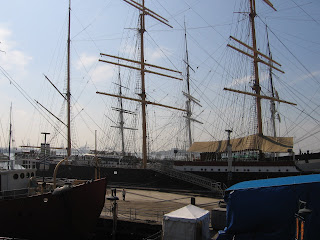
2:35 p.m. – Vicki called. She and Vicky are in Little Rock yet waiting to board their flight to Chicago, then on to Frankfurt, Germany and Istanbul. They arrive at the same time as we do.
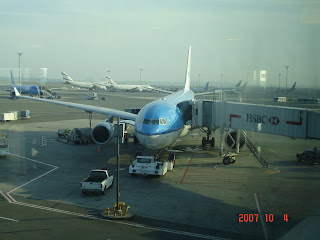 3:30 p.m. – We’re all checked in at JFK, having a few beers down at the gate waiting for our 5:40 pm KLM flight to Amsterdam to board. Another nice day for flying. I hope to sleep since we have a long day tomorrow.
3:30 p.m. – We’re all checked in at JFK, having a few beers down at the gate waiting for our 5:40 pm KLM flight to Amsterdam to board. Another nice day for flying. I hope to sleep since we have a long day tomorrow.6:20 p.m. – We just took off 40 minutes behind schedule, but we should arrive in Amsterdam almost on time at around 7:15 am tomorrow. The plane is full. We are in an A330 towards the back. Dave is across the aisle from me. I’m also on the aisle sitting next to a rather chatty 20-something-year old girl studying Interactive Technology, which has something to do with building websites that are easier for people to use. She lived in Holland for three years, but now living in New York City. She is going back to Amsterdam for a few days to visit friends before continuing to Africa.
8:00 p.m. – Just finished dinner, so will try to sleep. Each seat has its own personal screen, so you can pretty much watch or listen to anything you want to. I’m putting on my eye mask and sticking my ear plugs in. Good night for now. I’m tired since I woke up at 4:30 am.
Day 2 - Friday, October 05, 2007 - Istanbul, Turkey
Itinerary - Arrive and transfer to your hotel in Istanbul. Balance of the day at leisure.
 About Istanbul: Byzantium, Constantinople, İstanbul: by any name it's glorious. Straddling both the European and Asian continents along the Bosphorus River, Istanbul's skyline studded with domes and minarets, İstanbul is one of the truly great romantic cities. Its history tracks back from Byzantium to Constantinople to its place at the head of the Ottoman Empire. Today it hums as Turkey's cultural heart and good-time capital. In this sprawling, continent-spanning city of 38 square miles and 13 million people, you can tramp the streets where crusaders and janissaries once marched; admire mosques that are the most sublime architectural expressions of Islamic piety; peer into the sultan's harem; and hunt for bargains in the Kapalı Çarşı (Grand Bazaar).
About Istanbul: Byzantium, Constantinople, İstanbul: by any name it's glorious. Straddling both the European and Asian continents along the Bosphorus River, Istanbul's skyline studded with domes and minarets, İstanbul is one of the truly great romantic cities. Its history tracks back from Byzantium to Constantinople to its place at the head of the Ottoman Empire. Today it hums as Turkey's cultural heart and good-time capital. In this sprawling, continent-spanning city of 38 square miles and 13 million people, you can tramp the streets where crusaders and janissaries once marched; admire mosques that are the most sublime architectural expressions of Islamic piety; peer into the sultan's harem; and hunt for bargains in the Kapalı Çarşı (Grand Bazaar). Diary:
6:00 a.m. Amsterdam Time – 6 Hours Ahead of New York. Having breakfast. We arrive in Amsterdam in about an hour. I slept maybe 3-1/2 hours of the 6-hour flight to Amsterdam. We have a 5-hour layover in Amsterdam. That’s not enough time to go into the city, so we’ll just hang out at the airport. The food on this flight has been a lot better than I expected.
7:30 a.m. -- We’ve arrived. Can’t find any free Internet connections. We stopped for coffee.
10:00 a.m. – Had my first “Gate1” sighting. These are the people we’ll be traveling with in our tour group for the next two weeks. It’s a couple of older ladies (Kate and Marybelle).
11:30 a.m. – We’re on the plane—a Boeing 737. I saw no other Gate1 people. We’re about 20 minutes behind schedule. The plane is full of mostly Dutch tourists. They all are wearing hats saying “Cees 60” on them. I found out later that they are all flying to Istanbul for Cees’s 60th birthday party on Saturday, then coming home Sunday. Our flight to Istanbul will be 3-1/2 hours. Our route will take us over Germany, the Czech Republic, Romania and the Black Sea.
12:00 p.m. – Dave and I are sitting in the back next to the windows. I didn’t see my bag get loaded on. Maybe they put it on earlier when I wasn’t watching.
12:20 p.m. -- We’re off to Istanbul.
1:00 p.m. – I’m trying to sleep but the Dutch people are having a party. As soon as we took off, they all got out of their seats and started chatting with their friends on the plane. Those who aren’t roaming up and down the aisle are screaming to their friends in the front or back of the plane. Several of them are really intoxicated, like the guy next to me who has passed out in his seat. The alcohol on his breath is so strong that if I lit a match, he would blow up. It’s like being at a college beer party. Lots of commotion. Even my ear plugs can’t drown out the noise. These folks are just like the Dutch people I remember—very social.
4:00 p.m. Istanbul Time – (+1 hour from Amsterdam, +8 hours from US Central Time zone) – Flying out over the Black Sea off the Romanian coast. We were supposed to go here last year on our European River Cruise, but due to high water on the Danube, never got this far. I saw another large jet zoom past us a moment ago. It startled me because it was so close, even though it was a couple hundred feet below us and off to the right. We must be getting close to Istanbul. The weather is very nice. The captain said it’s 74°F with scattered clouds. By the time we deplane, get visas (I have mine already), grab our luggage, go through customs, meet our tour guide and drive to the hotel in downtown Istanbul, it will be at least 7 pm. Guess we won’t do much sightseeing today.
4:15 p.m. – We’re ten minutes from landing. I can see the Turkish country side. Looks like the US with rolling green hills, farmland and the occasional small town or village. There are a bunch of merchant ships out on the Sea of Marmara located just south of Istanbul. Of course, it’s not exactly like the US since the country is Muslim.
4:25 p.m. - Can see the suburbs of Istanbul. Very modern homes and subdivisions. Also lots of swimming pools.
 4:30 p.m. – We’ve landed in Istanbul. It was a bumpy landing. Saw several mosques as we came in. The Dutch tourists are singing and clapping—sounds like a Baptist church. I see the Lufthansa plane next to our gate. That’s got to be Vicki and Vicky’s plane. Vicky’s cousin Debbie is coming on a different flight. Don’t know if she’s here yet.
4:30 p.m. – We’ve landed in Istanbul. It was a bumpy landing. Saw several mosques as we came in. The Dutch tourists are singing and clapping—sounds like a Baptist church. I see the Lufthansa plane next to our gate. That’s got to be Vicki and Vicky’s plane. Vicky’s cousin Debbie is coming on a different flight. Don’t know if she’s here yet. 5:00 p.m. - The visa line was long, so I was glad I got mine ahead of time. It went fast though. I collected my luggage, which I was happy to see, and went outside the arrival terminal where I was greeted by Gate1 representatives and a couple other people in our group.
6:00 p.m. – Dave and I ran into Vicki and Vicky outside customs. Debbie’s flight to Chicago was cancelled. She’s traveling through Denver instead. We will see her later at the hotel I hope. We’re in a van on our way to the hotel. We picked up about 10 fellow Gate1 travelers. We thought we would go for a walk after checking into our hotel, but were just informed that there is an orientation and welcome dinner at the hotel at 7:30 pm.
6:15 p.m. – Great news. Vicki, Vicky, Dave, Debbie and I are all in the same hotel. I was worried that I would be in a different one because we forgot to tell Gate1 that we were traveling together. Gate1 worked things out for us so that we could all be together, but a guy named Ed (Group B) was switched with me, so he is at the Oran Hotel and I’m at the Prince. However, Gate1 did not tell him or me about the switch. Sadly, I was telling him my story about the hotel problem, and he ended up being the one who got shafted.
7:00 p.m. – Well, we’re almost to the hotel. It’s been a long drive. It’s Friday, which is like Saturday in the US. So everyone is off of work and doing their shopping, going out to eat, or whatever else they do when not working. It’s also Ramadan, so it’s extra busy. Ramadan occurs at different time each year. It’s been going on for 20 days and has another 9 or 10 to go. Practicing Muslims fast all day—no food or water during the daytime—only after sunset and before sunrise.
7:05 p.m. – Istanbul is very modern. Our driver is doing a great job maneuvering through the heavy traffic. We just passed over a bridge from the European continent to the Asian continent. Istanbul is on both continents. Gate1 sent Cihan (pronounced Jzhee-hon—almost like jihad!) to greet us. He is answering our questions about Istanbul, Turkey and himself. He’s 23, studies tourism and works part-time. He lives on the outskirts of town with his parents. Most unmarried Turks do this. His family owns a café restaurant and he drives one of his dad’s two cars to and from work. Sorry Vicky, he’s already taken. Istanbul has officially 13 million people, but unofficially, it’s like 15 million. The city of Istanbul is quite modern. There are many high-rise apartment buildings and condos. The city condos can cost over a million dollars. We noticed that gas costs 2.79 Turkish Liras (TRY) per liter, which is $9.17 per gallon at today’s exchange rate. There are lots of foreign cars—Japanese, German and American. Despite gas prices, there are a lot of cars on the road.
7:15 p.m. - We passed through several of the old city walls and aqueducts, which were built by the Romans hundreds of years ago. We’ll see more of this when we return to Istanbul for a few days at the end of our trip. We’re only here tonight, then heading to Canakkale and the ancient city of Troy tomorrow.
7:30 p.m. – I cheated. Although I said I wasn't going to, I got to my room, showered, shaved, brushed my teeth and changed clothes before coming down to the welcome dinner. I hadn’t bathed for over 24 hours since I was en route for that amount of time. Miraculously, Debbie arrived at the hotel as we were checking in. Glad she made it.
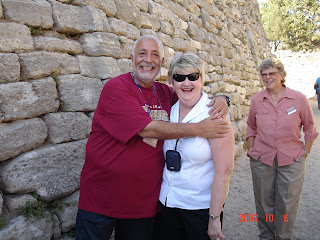 8:15 p.m. – We just got a 45-minute briefing in a meeting room at the hotel from Salih Gök (pronounced “Sally”), our tour guide, where he passed along some important information to make our trip enjoyable. We all introduced ourselves at the start. There are 7 or 8 people from Green Bay and several more from Michigan. We are largely a Midwest US group of travelers. We were warned to always ask price ahead of time because you can get ripped off easily or end up paying a lot more than you think.
8:15 p.m. – We just got a 45-minute briefing in a meeting room at the hotel from Salih Gök (pronounced “Sally”), our tour guide, where he passed along some important information to make our trip enjoyable. We all introduced ourselves at the start. There are 7 or 8 people from Green Bay and several more from Michigan. We are largely a Midwest US group of travelers. We were warned to always ask price ahead of time because you can get ripped off easily or end up paying a lot more than you think.
9:00 p.m. – Dinner was OK. We had salad, mushroom soup, bread and some mashed potato concoction with beef and sauce over it. We were told not to worry about eating fresh fruits and vegetables or drinking the water since they’re safe. We forgot the lesson about asking the price of beer, which wasn’t included in the meal. They were $6 a piece. OK, I’ll be asking the price ahead of time from now on.
 11:00 p.m. - Well, we walked all over for the past few hours. Our hotel in right in the middle of the major tourist sites—Aye Sophia, Topkapi Palace and the Blue Mosque. It was very busy and crowded. We admired the Turkish rugs, colorful tiles, and porcelains that the country is famous for. Of course, all the merchants were after our money. We also checked out the prices at the Turkish baths (hamans) where we are likely to end up for sauna and massage sooner or later.
11:00 p.m. - Well, we walked all over for the past few hours. Our hotel in right in the middle of the major tourist sites—Aye Sophia, Topkapi Palace and the Blue Mosque. It was very busy and crowded. We admired the Turkish rugs, colorful tiles, and porcelains that the country is famous for. Of course, all the merchants were after our money. We also checked out the prices at the Turkish baths (hamans) where we are likely to end up for sauna and massage sooner or later.  We also met a business man from Ohio who was sitting outside a café smoking a water pipe. Debbie got to experience what it’s like to smoke a houka. Like a bong, you put the tobacco in a cylinder. The tobacco is kept burning by placing it on top of apple-charcoal, which also adds to the flavor. The Ohio guy didn't cough after taking a giant hit off the pipe. But Debbie held it in for a few seconds before coughing up the acrid smoke. Way to go Debbie. We then strolled around the mosque areas where we saw a live religious band playing. After that, we found our way back down the narrow winding streets to the hotel. I’m tired.
We also met a business man from Ohio who was sitting outside a café smoking a water pipe. Debbie got to experience what it’s like to smoke a houka. Like a bong, you put the tobacco in a cylinder. The tobacco is kept burning by placing it on top of apple-charcoal, which also adds to the flavor. The Ohio guy didn't cough after taking a giant hit off the pipe. But Debbie held it in for a few seconds before coughing up the acrid smoke. Way to go Debbie. We then strolled around the mosque areas where we saw a live religious band playing. After that, we found our way back down the narrow winding streets to the hotel. I’m tired.Day 3 - Saturday, October 06, 2007 - Gallipoli, Troy & Canakkale, Turkey
Itinerary - This morning, cross the Dardanelles by ferry and drive via Gallipoli to the classical city of Troy. Tour this 4000 year-old city and legendary center of the Trojan War; see the city made immortal by Homer's epic poem the Iliad. Continue to the Canakkale province, located in northwest Turkey.
About Troy: Troy, with its 4,000 years of history, is one of the most famous archaeological sites in the world. The first excavations at the site were undertaken by the famous archaeologist Heinrich Schliemann in 1870. In scientific terms, its extensive remains are the most significant demonstration of the first contact between the civilizations of Anatolia and the Mediterranean world. Moreover, the siege of Troy by Spartan and Achaean warriors from Greece in the 13th or 12th century B.C., immortalized by Homer in the Iliad, has inspired great creative artists throughout the world ever since. The archaeological site of Troy is of immense significance in the understanding of the development of European civilization at a critical stage in its early development. It is, moreover, of exceptional cultural importance because of the profound influence of Homer’s Iliad on the creative arts over more than two millennia.
Diary:
4:00 a.m. – OK, I’m up already typing my diary and doing my travel finances. Even though I got to bed late, I couldn’t sleep. We have a wake up call sometime this morning. Breakfast is at 7 am and we depart Istanbul for Canakkale and Troy at 8 am.
8:30 a.m. – Another day in paradise. Weather is wonderful again. We had breakfast at the hotel, checked out and are now on the bus headed to Canakkale with a stop in ancient Troy along the way. We’ll be on the road all day.
9:00 a.m. – Seems like no one liked the hotel. My room was hot all night and there was nothing I could do about it. Vicky said their room was hot. So in the middle of the night she got up on the bed to stick her hand in front of the vent to see if the air was cool. As she got down off the bed she tripped on Vicki’s suitcase and took a fall. She landed on her wrist so now it’s a little swollen. Vicki and Debbie made sure she was OK before finding some humor in the situation. The hotel breakfast was so-so. There was a lot of bread. I was expecting Turkish coffee, but it came out of a Nescafe machine. And they were charging $4 for orange juice a la carte! They had the typical European breakfast offerings like yogurt, cereal, sandwich meats, jams, vegetables, fruit and cheese. For us Americans, they had hardboiled eggs, tomato slices with melted cheese on them, and cut up hotdogs in barbeque sauce. Hope it’s not like this everyday. We’ll be back here at the end of the trip.
 10:00 a.m. – We drove west out of town along the Bosphorus River. It was a pretty busy place with the ferry boats coming in from across the river and all the cruise ships. The area we’re driving through is called the Golden Horn since it looks like a horn from above. Salih, our guide, says the area has been cleaned up a lot thanks to UNESCO and others interested in preserving Istanbul’s rich history. Squatters had occupied many spots along the water to our right and many others in front of the old city wall to our left. They built these ramshackle homes with whatever money they had and ceased building them when the money ran out. They typically added another floor when they had the money or as the family grew. Many have never been completed. The old city walls were built in 400AD when Istanbul was known by its Greek name of Constantinople.
10:00 a.m. – We drove west out of town along the Bosphorus River. It was a pretty busy place with the ferry boats coming in from across the river and all the cruise ships. The area we’re driving through is called the Golden Horn since it looks like a horn from above. Salih, our guide, says the area has been cleaned up a lot thanks to UNESCO and others interested in preserving Istanbul’s rich history. Squatters had occupied many spots along the water to our right and many others in front of the old city wall to our left. They built these ramshackle homes with whatever money they had and ceased building them when the money ran out. They typically added another floor when they had the money or as the family grew. Many have never been completed. The old city walls were built in 400AD when Istanbul was known by its Greek name of Constantinople. 10:10 a.m. - We drove through the Jewish and Greek Quarters, and past a metal church from Bulgaria that was moved here after the Russians took over that country during WWII.
 10:10 a.m. - We’re marveling at the vast urban sprawl as we make our way down the expressway towards the outskirts of town. 25 years ago, only 2.5 million people lived in Istanbul. That number is now above 16 million. The true population isn’t known since they stopped taking the census a while back. When they took the census, they used to have a curfew. High schools kids then went door to door to count the number of people in their neighborhood. When done, the government would broadcast a message on TV so people knew when it was OK to go back outside and go about their business.
10:10 a.m. - We’re marveling at the vast urban sprawl as we make our way down the expressway towards the outskirts of town. 25 years ago, only 2.5 million people lived in Istanbul. That number is now above 16 million. The true population isn’t known since they stopped taking the census a while back. When they took the census, they used to have a curfew. High schools kids then went door to door to count the number of people in their neighborhood. When done, the government would broadcast a message on TV so people knew when it was OK to go back outside and go about their business. 10:15 a.m. – We’ve been told that the Turks are horse people and that camels are only for the tourists. We drove past a huge bus station and were told by our guide that trains were associated with Communism so the Turks stopped using them for public transportation. That view eventually faded away and trains are used again. There are over 1,000 bus companies in Turkey because each town has its own bus service. They bring the villagers into the city and take them back home at the end of the day.
10:20 a.m. - Where do the Turks come from originally? Central Asia. Mainly the Mongolian region. They were nomadic and one of the reasons China built the Great Wall. To keep them out. The Turks are closest to the Hungarians. Attila the Hun was a nomadic Turk and was called a Hun because he settled in what is now Hungary. The original Turks also closely resemble American Indians right down to the totems, tepees, physical appearance and ancient beliefs. Is it possible the American Indians and Turks are related, having also come from Central Asia and reaching North America by way of the Bering Strait? Except for Georgia and Armenia, all of the former Soviet satellite countries in central Asia have people of Turkish decent. Today there are no pure Turks. They have mixed with all of the other peoples who settled in the area over the centuries.
10:30 a.m. – We learned that there is no government housing or apartment management companies in Turkey. The hundreds of high-rise dwellings we see in all directions are condominiums and co-ops. There is usually a business on the street level of each one. There is also one family in each building who does the cleaning and maintenance of the building and common areas. They live for free, but do a lot of work. The wife picks up extra money by cleaning peoples’ apartments.
10:35 a.m. - We drove by this vast area of the city called the Furniture District. It’s so big it looks like a suburb and has over 4,000 furniture stores.
10:40 a.m. The Turkish language was never written down until the Turks agreed to come under the rule of their friends the Arabs. They created a phonetic language with 29 letters using the Hindu-Arabic alphabet like we have. The Turks were also not Muslim originally, but more like the Indians in India. But the ruling Arabs required the Turks to adopt their religion and traditions, so the Turks eventually became Muslim.
10:45 a.m. – OK, were starting to get out of the city and into the countryside now. We’re driving south along the Dardanelles Strait where we will eventually board a ferry boat and go south to the other side. We’ll catch the boat in Gallipoli on the European continent side and get off on the Asian continent side in Canakkale.
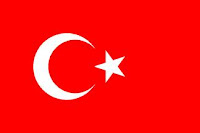 10:50 a.m. – The Turkish flag is a moon and star with a red background. This originates from ancient times when the Turks, like American Indians, worshipped objects in the heavens and skies.
10:50 a.m. – The Turkish flag is a moon and star with a red background. This originates from ancient times when the Turks, like American Indians, worshipped objects in the heavens and skies.11:00 a.m. - Coffee does not come from Turkey, but Ethiopia via Yemen. It was introduced by the Ottomans. Traditional preparation is a long process. After roasting and grinding the beans to a consistency finer than espresso, it is added to cold water and slowly boiled until it become rich and flavorful.
11:15 a.m. – We’re getting a language lesson. The word “um” is a very bad one. But English-speaking people use it all the time when they are at a loss for words. I will have to find out what it means, but I think it has something to do with female anatomy (yes, it's the 4-letter “C word” that men sometimes call women). If you make the OK sign with your hand, but hold your hand backwards, it is also bad. I think it means “you’re and asshole.” Salih won’t announce publicly what they mean, so I’m going to have to ask later. Also, if you make a fist with your thumb sticking out between your index and middle finger, it is a 1,000 times worse than the finger. Someone might pull a gun on you if you gesture at them in this way.
11:25 a.m. - The group is all jet-lagged and dozing in and out of consciousness. We’re learning that only 3% of the country is on the European continent. If your hold up your left hand with your palm facing you, the European part would be your thumb. The rest is in Asia. Turkey has switched hands many times. First it was Greek, then Roman. The buildings and infrastructure all around the country reflect the influences of the different occupiers and rulers, hence, Turkey is known as the "Cradle of Civilization." Also, despite being Muslim, there are more Christian buildings and churches in Turkey than anywhere else in the world. Several of the apostles (Paul, Peter, John, Matthew), as well as the Virgin Mary lived in Turkey. The 7 Apocalypse churches from the Book of Revelation are also here. We’ll see several of them along our way.
11:30 a.m. - The population in Turkey is 97% Muslim but 70% faithful. Although alcohol is forbidden, 60% consume it because the country is so secular. It’s a land of contradictions in this way. Those who drink alcohol justify it by saying they will “quit soon.” There are 100,000 mosques in Turkey. I believe it.
11:45 a.m. – There are 22 million tourists coming to Turkey each year. Most come from Europe and Asia. Only 150,000 come from the US. We are different in that we get on busses and tour the country. The Asians (especially the Japanese) rush through it for pictures and leave. The Europeans go to the Aegean, Black Sea or Mediterranean coast and hang out at the beach—virtually.
 12:00 p.m. - Stopping at a gas station for a bathroom break. There are 20 busses parked here. We’re up in the Taurus Mountains.
12:00 p.m. - Stopping at a gas station for a bathroom break. There are 20 busses parked here. We’re up in the Taurus Mountains. 12:20 p.m. - Getting close to lunch and the ferry in Gallipoli. The coast is beautiful. Turkey is an agriculture country. It is one of the few that is an exporter of food. Vegetarians would have a hard time here. There is a lot of meat here. The biggest exports are tobacco and cotton. 95% of the power is hydroelectric. All farms are family-owned—no big corporations. There are no farm houses because people live in villages and commute back and forth from the fields. The women do all the work, which explains why we see a lot of men sitting around playing backgammon. There is no hired help on the farms—the families do all the work themselves. Farmers also pay no taxes. The middle man who takes the crops to be sold has to pay it.
 1:30 p.m. - We stopped in the little seaside town of Gallipoli for lunch while we wait our turn on the ferry. We admired all the small fishing boats in the harbor area and walked around taking pictures. Eventually we stopped at a little mom-and-pop restaurant. Vicki and Dave had some sort of meat sandwich. Apparently they were good. Vicki loved the bread. The sanitary conditions fouled my appetite. Vicky and Debbie shared a grilled cheese sandwich. It wasn’t on the menu, but they made it anyway. We also had some fries, which probably would have tasted better if they were hot. At least they had ketchup.
1:30 p.m. - We stopped in the little seaside town of Gallipoli for lunch while we wait our turn on the ferry. We admired all the small fishing boats in the harbor area and walked around taking pictures. Eventually we stopped at a little mom-and-pop restaurant. Vicki and Dave had some sort of meat sandwich. Apparently they were good. Vicki loved the bread. The sanitary conditions fouled my appetite. Vicky and Debbie shared a grilled cheese sandwich. It wasn’t on the menu, but they made it anyway. We also had some fries, which probably would have tasted better if they were hot. At least they had ketchup.  Vicky and I then went off shopping while Dave, Vicki and Debbie went a different direction. We found some tapes for Vicky’s video camera and ventured into the local fishing market and a few pharmacies before going down to the harbor front to take pictures.
Vicky and I then went off shopping while Dave, Vicki and Debbie went a different direction. We found some tapes for Vicky’s video camera and ventured into the local fishing market and a few pharmacies before going down to the harbor front to take pictures.  I took a good picture of Vicky with some young Turks for her wall at the office back in Little Rock.
I took a good picture of Vicky with some young Turks for her wall at the office back in Little Rock. 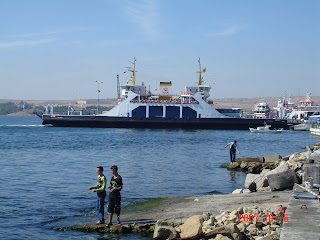 1:45 p.m. – We’re on the ferry boat heading to the other side of the Dardanelles Strait. We got off the bus and strolled the upper decks of the ferry, which was full of tourists.
1:45 p.m. – We’re on the ferry boat heading to the other side of the Dardanelles Strait. We got off the bus and strolled the upper decks of the ferry, which was full of tourists. 2:15 p.m. - We’ve reached the other side and are back on the bus in Canakkale driving to ancient Troy, of Trojan Horse fame, for a late afternoon tour. It’s about 40 minutes away. We’ll come back to Canakkale and our hotel later this afternoon. Canakkale means “bowl fortress” because the fort is in the shape of a bowl. Canakkale is pronounced “Chah-nah-kah-lee.” The Dardanelles Strait is 40 miles long and 750 yards wide at its narrowest point.
2:45 p.m. - We’re learning the history of Gallipoli. The Battle of Gallipoli took place at Gallipoli, Turkey from April 1915 to December 1915 during World War I. Turkey had allied with Germany. A joint Imperial British and French operation was mounted to capture the Ottoman capital of Istanbul and provide a secure sea route for military and agricultural trade with the Russians. The attempt failed, with heavy casualties on both sides. Winston Churchill, who was then a leader in the British Navy, tried to take the Ottomans (Turks) out of WWI by controlling the country and the sea supply routes to Russia and Asia. Although Turkey won the battle, it didn’t matter because the Germans eventually lost. Luck and the skill of Turkish military leader Ataturk thwarted this effort by mere simple mining of the Dardanelles Strait where the British lost several ships. The Australian/New Zealand soldiers also took a beating from the Turks, but casualties were very high on both sides. Today, the Turks and Australian/New Zealanders don’t have any animosity towards one another. In Turkey, the Battle of Gallipoli is perceived as a defining moment in the history of the Turkish people - a final surge in the defense of the motherland as the centuries-old Ottoman Empire was crumbling. The struggle laid the grounds for the Turkish War of Independence and the foundation of the Turkish Republic eight years later under Atatürk, himself a commander at Gallipoli.
3:00 p.m. – Making a last “safe” bathroom stop before Troy. The gas station has a little zoo with chickens, monkeys, cranes, rabbits, parakeets, and even two golden retrievers in cages.




 3:25 p.m. We’re in Troy. The city is actually nine cities built one on top of the other over hundreds of years, starting in 3,000 BC. There was a giant wooden Trojan Horse statue near the gate that you could climb up and inside of. There is also a Trojan Horse from the movie Troy on the waterfront across from our hotel in Canakkale. The movie was never filmed in Troy though.
3:25 p.m. We’re in Troy. The city is actually nine cities built one on top of the other over hundreds of years, starting in 3,000 BC. There was a giant wooden Trojan Horse statue near the gate that you could climb up and inside of. There is also a Trojan Horse from the movie Troy on the waterfront across from our hotel in Canakkale. The movie was never filmed in Troy though. 


5:00 p.m. – We’ve finished touring Troy. It was a lot of ancient ruins. We also stopped for pictures with the Trojan Horse. I think everyone is tired and jetlagged. We’re stopping at the gift shop before heading 20 minutes back to Canakkale.
5:30 p.m. – Almost back to Canakkale. Vicki came back from the gift shop with an Efes Pils beer for Dave and I. Mmmmm. I needed one after the long day of sightseeing and travel.
6:00 p.m. - Salih says Turkish kids don’t typically go to bed till midnight even with school. I’m wondering when the parents have time for themselves. They spend a lot of time with kids. Also, the people are very friendly. When you move into a new house, the neighbors help you move in. Maybe to see what kind of stuff you have. Friends also just drop by unannounced and it is bad etiquette to refuse them, so you just open your door and visit with them. If it gets too late, they just stay over, sometimes on the weekend for three days. During funerals and weddings, your neighbors do everything for you—clean the house, shop, drop the kids off at school, and so on. I’d like to have a few of them come over and do my housekeeping and shopping.
6:15 p.m. – We’re talking about the family that does the cleaning and maintenance work at your condo or co-op again. The monthly condo fee is only $10 per month. For that, they will even pick up stuff for you at the store when they go shopping. I like that idea but I don’t think Brenda back in Milwaukee would like it too much.

 7:00 p.m. - Gate1 is providing buffet dinner back at the hotel. Dave and I strolled the harbor front and watched several fishermen with long poles fishing for some sort of small fish. We then took a few photos of the wooden horse from the movie Troy and walked past all the cafes along the waterfront. Nice little town. The sun was going down so will have to get up early in the morning and take some pictures of the town. I’m really tired.
7:00 p.m. - Gate1 is providing buffet dinner back at the hotel. Dave and I strolled the harbor front and watched several fishermen with long poles fishing for some sort of small fish. We then took a few photos of the wooden horse from the movie Troy and walked past all the cafes along the waterfront. Nice little town. The sun was going down so will have to get up early in the morning and take some pictures of the town. I’m really tired. 
8:00 p.m. – Dave and I had dinner right at 7. The lock on Debbie’s suitcase jammed so they had to saw it off. So the girls were late for dinner. I excused myself early and went to bed. The hotel is nicer than the one yesterday, and the bed actually looks comfortable.
Day 4 - Sunday, October 07, 2007 - Pergamum to Izmir, Turkey
Itinerary - Drive to Pergamum, a powerful kingdom during the ancient Hellenistic period (289-129 B.C.), and visit the Acropolis, an impressive construction which houses the Temple of Trajan, the Heroon shrine, the Sanctuary of Athena, the Altar of Zeus, the Theater and the Library of Pergamum, built by King Eumenes II, and whose collection came second only to that of Alexandria's. Interestingly, however, the Acropolis in Pergamum functioned opposite the Acropolis in Athens, centering its purpose on the "daily life" of its citizens rather than religious worship. Continue to Izmir, a city believed to be the birthplace of Homer.
About Pergamum: The history of Pergamum starts in the 8th C BC when Aeolian Greek colonies settled in the area. The city was founded on a hill overlooking the Caicos plain. During the reign of Eumenes II in the 2nd C BC, it became one of the cultural and intellectual centers of the day. With the invention of pergamena (parchment) its library grew to rival in size, the great library of Alexandria. Pergamum was one of the Seven Churches of the Revelations. The famous Roman physician, Galen was born and studied in Pergamum.The ruins are separated into 3 parts, the Acropolis, Red Courtyard and Asclepion, which was the cure center of Pergamum.
Diary:
1:30 a.m. – Well, I slept from 8 pm to 1:15 am. I couldn’t get back to sleep so started typing my journal. The Hotel Akol’s free Internet works in my room. Nice.
3:00 a.m. – Done typing yesterday’s journal now and making mistakes. So time to go back to sleep until the 7 am wake up call.
7:00 a.m. - This is going to be a long day. We're traveling south 200 miles from Canakkale to Izmir, with a stop in ancient Pergamum along the way. The weather is perfect once again with clear skies, 85ºF and low humidity.
8:30 a.m. – I fell asleep again at 3:30 am only to be awoken by loud bass drum playing out on the street a half hour later. Since it’s Ramadan, the local Muslims need to be reminded to get up before sunrise and have dinner. They fast all day until sunset, so eating in the morning is important. I thought it was an explosion, so got up and went out on my terrace to see what was going on. Then I went back to bed and didn’t wake up until my 7 am wake-up call. The breakfast at the hotel was just OK. At least they had orange juice and scramble eggs on the buffet line but they ran out of a lot of stuff. One person in our group came back with an empty plate because she couldn’t find anything she liked. The best thing about this hotel was the free Internet access. I brought my laptop to breakfast and several people in our group checked their e-mail on it until we had to board the bus and leave for Pergamum.
8:35 a.m. - Although we were the last to get on the bus, no one sat in the back. So we got our spots in the very back of the bus again as usual.
8:45 a.m. – OK, we’re cruising down the highway. It’s a mountainous region with winding roads and this green vegetation.
8:50 a.m. – People on the bus are asking Salih about himself. I guessed correctly that he was 53. He said he has been in the tourism business on and off for 35 years since graduating from high school, so that comes to 53 in my book. He has known his wife all his life. They were childhood friends. She came to the US to get her nursing degree and invited him over for 15 days. This is in the late 70s. On the 10th day, she asked him to marry her. He agreed and stayed in the US for several years where his 22 year old son Jason is living. Jason is in Boston getting his masters degree, but Salih and his wife are back in Turkey. She works for the university but picks up extra money during the tourist season as a tour guide 50 days a year on the ferry boats in Istanbul. He says he has 4 wives. In reality, he went through 4 different marriage ceremonies with his wife. Once in the US and several times in Turkey with both sides of the family. Muslim religion says you can have 4 wives. But it is impossible to have more than one because in order to have a second wife, the prophet Mohammad said you had to love each equally, which is impossible. Legally now, it is only permitted to have one wife. This contradicts religion but exists because Turkey is so secular. Outside of Turkey, other Muslims can have more than one wife.
8:55 a.m. - We learned that it is taboo for two unmarried people of marriage age and the opposite sex to be in the same room together. If you want to get divorced, all the man has to say is “I divorce you” three times and it is done. The divorce rate is < 1% in Turkey.
 9:05 a.m. – Vicky got ripped off on an “evil eye” bracelet last night from a street vendor. It cost $5 but the vendor would only give her back $10 change for her $20 bill. He gave her a handful of ceramic evil eye beads like the ones on her bracelet as compensation. She gave me one and will give the others to kids in Little Rock.
9:05 a.m. – Vicky got ripped off on an “evil eye” bracelet last night from a street vendor. It cost $5 but the vendor would only give her back $10 change for her $20 bill. He gave her a handful of ceramic evil eye beads like the ones on her bracelet as compensation. She gave me one and will give the others to kids in Little Rock. About the "Evil Eye": In Greece and Turkey, evil eye jewelry and trinkets are particularly common. Colourful beads, bracelets, necklaces, anklets, and all manner of decoration may be adorned by this particularly popular symbol, and it is common to see it on almost anything, from babies, horses, doors to cars, cell phones and even airplanes. Belief in the evil eye is found in Islamic doctrine based upon a verse in the Koran: "And from the evil of the envier when he envies." Authentic practices of warding off the evil eye are also commonly practiced by Muslims. Rather than directly expressing appreciation of, for example, a child's beauty, it is customary to say Masha'Allah, that is, "God has willed it", or invoking God's blessings upon the object or person that is being admired. If the individual invoking the blessing is actually envious or jealous, you have received the evil eye and need the evil eye amulet to prevent anything bad from happening to the person being admired by the jealous person.
9:30 a.m. – Olive Oil History – Olive oil making is big in Turkey and the process is special. You leave the pits in the olives and mash them up into a peanut butter consistency and put them in a press. The pit makes them sweeter. The first pressing gives you extra virgin olive oil. But a lot of oil is left behind so they put the olive mash in hot water and press them again to get more oil out of them. Olives right off the tree are bitter. Their more palatable flavor comes from soaking them in brine. An olive tree does not bear fruit for seven years.
10:45 a.m. – Education System in Turkey—Education is free all the way through college, even if you want to become a doctor or a lawyer. From grades 1-5, you have the same teacher for all the years and all your subjects. In Istanbul, classes usually have 45-50 kids, but in smaller cities, it’s more like 15-20. You go to school for half a day, either in the morning or the afternoon. The teacher also works only half the day. In junior high school, the teachers rotate from room to room, not the kids. Because there are too many kids, you have to take an entrance exam to get into college—or in this case, elimination exams. It’s a 180-question test that you only get to spend a minute or two on each question. They have tutors who train the kids to be good test takers. It is very expensive. So even the brightest child may not go on to college if he or she is a poor test taker. Because of the free system, doctors and teachers have to work for the state for 3 years before having the freedom to go wherever they want. A good teacher makes more than an engineer. And they are so revered that there are special resort villages where the teachers can vacation with their families very cheaply. If you don’t make it into college, there are special trade schools.
 10:50 a.m. – We’re driving up and over the mountains along the coastline. We can see the island of Lesbos in the distance. It is part of Greece, which has several islands just off the coast of Turkey. It has an air force base on it among other things. The Greeks and the Turks are very much alike since Turkey was once part of Greece. The Greeks still call Istanbul by its former name, Constantinople, the City of Constantine. Despite their occasional border skirmishes, they do like each other. We heard the story about two Olympic runners, one Greek and other Turkish. On the day they were to race for a gold medal, the Turk runner was killed in a car accident. The Greek runner won the gold medal but refused to stand on the highest place on the medal stand and would only allow the gold medal to be placed in his hand, not around his head. He knew that he would have finished second had the Turk runner been there. They then put the gold medal on the Turk's coffin as he was being buried. So the Greeks and Turks do get along.
10:50 a.m. – We’re driving up and over the mountains along the coastline. We can see the island of Lesbos in the distance. It is part of Greece, which has several islands just off the coast of Turkey. It has an air force base on it among other things. The Greeks and the Turks are very much alike since Turkey was once part of Greece. The Greeks still call Istanbul by its former name, Constantinople, the City of Constantine. Despite their occasional border skirmishes, they do like each other. We heard the story about two Olympic runners, one Greek and other Turkish. On the day they were to race for a gold medal, the Turk runner was killed in a car accident. The Greek runner won the gold medal but refused to stand on the highest place on the medal stand and would only allow the gold medal to be placed in his hand, not around his head. He knew that he would have finished second had the Turk runner been there. They then put the gold medal on the Turk's coffin as he was being buried. So the Greeks and Turks do get along. 11:15 a.m. – We stopped at a gas station to use the bathroom. The owner’s wife is handing out “evil eye” pins for us to wear. They are a sort of protection charm to ward off bad things from happening to you after you encounter jealous people. So, someone might come by and say what a lovely baby you have, but not really mean it. This keeps your baby from getting sick later. Or so they say. It’s a Middle East custom.
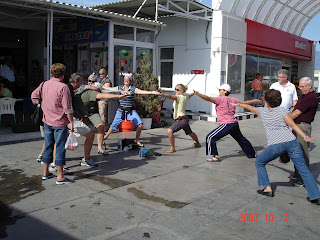 11:20 a.m. - Some members of the Green Bay group are practicing yoga in the parking lot of the gas station. You need this after sitting on a bus so long. A Turkish man getting gas is mimicking their moves.
11:20 a.m. - Some members of the Green Bay group are practicing yoga in the parking lot of the gas station. You need this after sitting on a bus so long. A Turkish man getting gas is mimicking their moves.11:30 a.m. - We’re hearing about Turkish family life. Many people have large extended families that stay physically close to one another. Abortion is not a public issue like it is in the US. It’s between you and your doctor. People don’t talk about it. It’s your business. We learned that doctors can override the Muslim religion, so if you can’t fast during Ramadan, you can get a doctor’s excuse. In the western part of Turkey, it is very Western with people having 2 kids, and 3 at most. The east part of the country is more traditional. They can have up to 15 kids. Elderly people never live alone. They live with family or very close by. There are no nursing homes here. You spend all your money on your kids in hopes that they will take care of you when you get old. You then have no savings when you retire. The nice part of an extended family is that you always have your parents as babysitters. The grandparents are really the most respected people in the household. You never reprimand your children in front of your parents. The grandparents get a monthly pension that is part of the household income but spent at their discretion. So if your parents say they will buy you a computer later, and you want one now, your grandparents usually will take you to get it today. Nice.
There are a lot of arranged marriages in Turkey. The men always are six years older than their wives. They do military duty for two years after high school and are really ready to get married when they get out. So the wife is usually 16 when this happens and the man is 22. While he is in the service, his mother looks for a girl to marry him. When he gets out she arranges a social visit to the girl’s home. The potential future wife stays away until it’s time for coffee at the end of the visit. The girls hide in the kitchen and size him up. If they like him, they put a lot of sugar in his coffee. If they don’t, they put salt in it. The boy never makes a face when drinking the coffee so you never know whether the girl wants to see him again or not.
Arranged marriages are a problem if the girl is in love with someone else. If she commits suicide to get out of it, that is better than running away and eloping. Eloping brings great shame to the family and can be justification for hunting down the daughter and killing her.
After marriage, the young couple usually lives with the parents. There is no privacy. But there usually isn’t much sex early on. The mother usually takes the future daughter-in-law to the baths so she can see what the daughter looks like naked before her some does. Only gold is given as a wedding gift from relatives. When they move into their own place, the girl’s parents buy them bedroom furniture and the boy’s family buys them appliances. They use the gold wedding gifts to pay for anything else they need.
12:00 p.m. – Social Systems in Turkey – They have socialized medicine. Everything is free. The medicine is good, but the system is crowded. Your goal to getting through the system fast is to get a referral to a specialist. Otherwise, you do a lot of running around to get the care you need. Once you’re in the hands of a specialist, things go much smoother. There is a private health insurance system that pays 80% of costs and allows you to get around the hassles of the public system.
The social security system is sweet. You can retire at 40 with 25 years of service for men and 20 for women. Since men only live on average to 65, this is good. When you retire you get a lump sum amount that you can use for whatever you want. Many use it to buy a business or something else that will provide some sort of income. You also collect a monthly income. Wherever we go, we always see lots of men with nothing to do sitting around playing backgammon. We haven’t seen a lot of older women on the streets.
1:00 p.m. – Taxes in Turkey – There are no 1040s, H&R Blocks, or long lines at the post office on April 15. Your taxes are taken out of your paycheck and that’s it. You trust your employer does it right. By the way, employers must pay the cost of transporting people to and from work, which is usually by bus. The income tax is very high. The minimum rate is 30%, but could be as high as 50% for the wealthiest. There is an 18% VAT on most common goods, plus other taxes on cell phones, car registration, etc.—all things they learned from the West. The real estate tax is 1% of its market value.
1:15 p.m. – 75% of all hazelnuts come from Turkey. High percentages of the world’s apricots and pistachios also come from Turkey.
 1:30 p.m. – We’re here in ancient Pergamum for lunch. The group had lunch. I walked around town towards the Acropolis snapping photos of the town, including St. John the Divine church, one of the 7 Apocalypse churches from the Bible.
1:30 p.m. – We’re here in ancient Pergamum for lunch. The group had lunch. I walked around town towards the Acropolis snapping photos of the town, including St. John the Divine church, one of the 7 Apocalypse churches from the Bible. We’ll be going up to the Acropolis after lunch. This is where the ruling family lived. It sits high on a hilltop above town, but lies mostly in ruins today.
We’ll be going up to the Acropolis after lunch. This is where the ruling family lived. It sits high on a hilltop above town, but lies mostly in ruins today.  After walking the town, I met the group back at the bus in town. Some boys wanted to practice their English and have my autograph, so I signed the inside back cover of one of their math books and took their picture. Vicky missed her chance to pose with some more young Turks.
After walking the town, I met the group back at the bus in town. Some boys wanted to practice their English and have my autograph, so I signed the inside back cover of one of their math books and took their picture. Vicky missed her chance to pose with some more young Turks. 1:45 p.m. - The ruins of Pergamum are amazing, although we heard Ephesus is far more awe inspiring. Pergamum was a resting spot for Alexander the Great and his army as they pushed east. When he moved on, he left an outpost here to secure the area. After he died, he left his conquered western territory to one of his generals, who came to Pergamum. When the general died, the mayor declared himself Prince of Pergamum and built the Acropolis. This was 200 BC. The Prince was a Hellenistic Ruler (follower of Alexander the Great) and ruled the buffer zone between Greece and Persia (Iran). The Pergamum Empire lasted only 150 years and was turned over to the Romans without a fight. At its height, Pergamum has 175,000 people, which is hard to imagine since the town is quite small now.
3:00 p.m. – We toured the entire Acropolis, admiring the Greek columns, and temple ruins. There are three types of column styles—Doric, Ionic, and Corinthian.




We also admired the Hellenistic Wall, the Byzantine Wall and the Zeus Altar, next to which was this tree with hundreds of white cloth bows tied to it. We also toured the areas beneath the Acropolis, which contained all the arches and supports for the terrace floor and temples above. We got some great pictures. We also looked down the hillside below the Acropolis at this huge theater in the mountainside that once held 20,000 people. The Nazis stole many treasures of Pergamum during WWII. They now reside in the Pergamum Museum in Berlin, which I visited in 1995. We were told the Byzantine Empire never existed. It was called the East Roman Empire in its time. Byzantine is apparently some fabrication.





3:05 p.m. - We’re on our way back down the windy hill and heading 2 hours to Izmir where we will spend the next two nights.
 8:00 p.m. – We checked into our Hotel, the Kaya Prestige a few blocks from the waterfront and headed down to the waterfront. It was beautiful with its pine trees and palm trees.
8:00 p.m. – We checked into our Hotel, the Kaya Prestige a few blocks from the waterfront and headed down to the waterfront. It was beautiful with its pine trees and palm trees.  We found a café and enjoyed a few drinks before heading back to the hotel for dinner. For the first time, both Gate1 groups are staying in the same hotel. It should be like this for a few days before we get to Ankara. Dinner was OK. Going to bed early again. I haven’t really adjusted to the time difference.
We found a café and enjoyed a few drinks before heading back to the hotel for dinner. For the first time, both Gate1 groups are staying in the same hotel. It should be like this for a few days before we get to Ankara. Dinner was OK. Going to bed early again. I haven’t really adjusted to the time difference.Day 5 - Monday, October 08, 2007 - Ephesus, Turkey
Itinerary - Full Day Ephesus & House of Virgin Mary - Ephesus is situated in the fertile Ionian landscape and famous throughout history for its Temple of Artemis, one of the seven wonders of the world. Ephesus is considered to be the showpiece among all the antique cities of the world. Leave hotel for Ephesus and first visit the House of Virgin Mary. Virgin Mary accompanied St. John to Ephesus, where she spent her last years living near a grove of olive trees close by to Ephesus. A visit is considered to be a Pilgrimage by the Vatican. You may collect holy water from the sacred spring. Visit the Basilica of St. John who came here and wrote his gospel and the Temple of Artemis. Ephesus was undoubtedly, one of the most important cultural centers of the ancient world and among its impressive structures you will marvel at the Library of Celcus, Temple of Hadrian, the Theater and the Odeon.
About House of the Virgin Mary: The House of the Virgin is believed to be the last residence of the Virgin Mary, mother of Jesus. The peaceful site is sacred to both Christians and Muslims. According to predominant Christian tradition, Mary was brought to Ephesus by the Apostle John after the Resurrection of Christ and lived out her days there. This is based mainly on the traditional belief that John came to Ephesus (see St. John's Basilica) combined with the biblical statement that Jesus consigned her to John's care (John 19:26-27). Archaeologists who have examined the building identified as the House of the Virgin believe most of the building dates from the 6th or 7th century. But its foundations are much older and may well date from the 1st century AD, the time of Mary. The modern history of the Virgin Mary's House is unusual. It was "discovered" in 1812 by a German nun, Sister Anne Catherine Emmerich, who never traveled away from her home. Sister Emmerich, an invalid confined to bed, awoke in a trance with the stigmata and visions that included the Virgin Mary and Apostle John traveling from Jerusalem to Ephesus. She described Mary's house in detail, which was recorded at her bedside by a writer named Brentano. Emmerich described a rectangular stone house, which John had built for Mary. It had a fireplace and an apse and a round back wall. The room next to the apse was Mary's bedroom, which had a spring running into it. The German nun went on to say that the Virgin Mary died at the age of 64 and was buried in a cave near her house. When her coffin was opened soon after, however, the coffin and burial shroud were empty. The house was then turned into a chapel. Years after Emmerich's visions, a French clergyman named Gouyet read Brentano's account and traveled to Ephesus to find the House of the Virgin. He found a house matching the nun's description and sent word to the bishops of Paris and Rome, but didn't receive much of a response. On June 27, 1891, two Lazarist preists and two Catholic officials set out to Ephesus to see the house. They found a small chapel in ruins with a damaged statue of the Virgin. Since 1892 the House of the Virgin has been a Catholic pilgrimage site. It was restored by 1897 and a shelter for visitors was set up. The Meryama was later visited by Popes Paul VI and John Paul II, who confirmed its appropriateness as a place of pilgrimage. The small, T-shaped stone building consists of a bedroom (on the right) and a kitchen (on the left). The interior is kept simple and austere, fitted only with an altar, images of Mary and candles. The spring that runs under the Virgin's House is believed to have healing properties, and many miracles have been reported. Inside the house are crutches and canes said to be left behind by those who were healed by the sacred spring.
About Ephesus: Ephesus is one of the best-preserved ancient cities in the world with a history dating back the 12th century BC. It was an important trade and religious center. During the Roman period its population reached about 250,000. One of the seven wonders of the world, Temple of Artemis was in Ephesus. It is also the site of one of the Seven Churches of Revelation. St. Paul lived and preached for about 2 years in Ephesus. Today it is estimated that between 15-20% of the city has been excavated. Some of the highlights are the Odeon, Celsus Library, Great Theater, Commercial Agora, Terrace Houses, Blue Marble Street, Scholistica baths and Brothel.
Diary:
4:30 a.m. - I’m up early again. I slept till about 2 am, which is 6 hours of sleep. I typed up yesterday’s journal. I don’t want to fall behind. I also finished my postcards. We go to Ephesus today. It will be a real treat.
8:30 a.m. – It’s another beautiful day—sunny and around 80º F. We are on our way to Ephesus, about and hour away.
9:00 a.m. – Islamic Religion—A Muslim is someone who follows the Islam religion. There are 1.7 billion Muslims in the world. They live in 50 out of the 190+ countries in the world with the largest population living in Indonesia. The religion originated 600 years after Christ. Mohammed is the prophet. Mohammed was a regular person before becoming the chosen one at age 40. His parents had died, he was married, and had three children. Then the archangel Gabriel came down and told him he was the chosen one. It took Mohammed 23 years to write the Koran, which was told to him by Gabriel. At the time, Paganism (worshiping more than one god) was all the rage. Paganism was not right. Mohammed spread the word and convinced enough people in Medina to help in his crusade to wipe out Paganism and overthrow Mecca. They destroyed all the Pagan symbols but kept the buildings. People now flock to Mecca to touch all the same buildings Mohammed and Abraham touched. A mosque is an Islamic temple. It means “ get together place.”
Muslims can recite their daily prayers anywhere except on Fridays when it must be done at the mosque. The idea is that you come together as a congregation at least once a week. Friday was chosen because the Jews worshipped on Saturday and the Christians on Sunday. You pray five times a day - sunrise, noon, mid-afternoon, sunset and before you go to bed. There is a call to prayer. It is now done over a loud speaker. In the big city, the Hojahs (imams) take turns calling their faithful to prayer one after the other so they don’t overlap and drown out each others’ calls to prayer. They basically all say the same thing—10 lines that basically say God is great, don’t forget your other world, be thankful for what you have, praying is better than sleeping. In smaller towns, someone goes down the street beating on a drum, like we heard in Canakkale the other day.
Muslims live by two sets of rules:
The first set has 6 rules that must be obeyed or believed—all or nothing—otherwise you can’t be a Muslim. 1) God is one and only god. 2) The chief angel is Gabriel, who is said to have appeared to Mohammad. 3) Mohammed is the last and greatest prophet. Anyone who says they are a prophet after Mohammed should not be believed. So, from an Islamic perspective, proclaimed prophets like David Koresh and Jim Jones were not really prophets like they claim. 4) The Koran is the last book and the summation of all other books like the Torah and the Bible and supersedes all previous writings. 5) Allah has determined what he pleases and no one can change what he has decreed. It is said that Ayatollah Khomeini could not be a Muslim since he tried to impose a subsequent 13th century interpretation of the Koran on other Muslims. Iran also has its own interpretation which explains a lot. 6) On the “last day,” the dead will be resurrected. Allah will be the judge and each person will be sent to heaven or hell. Heaven is a place of sensual pleasure. Hell is for those who oppose Allah and his prophet, Mohammad.
The second set of rules you must live by to be Muslim is called the Pillars of Islam. There are five rules to live by. You must 1) pray 5 times a day, 2) fast during Ramadan (sun up to sundown for 30 days—no food or drink of any kind), 3) go to Pilgrimage in Mecca at least once in your life provided you are healthy and wealthy, 4) must give alms after taking care of your personal living needs (alms are equal to 1/40 of your net worth, that’s 2.5%. So if you are worth $100,000, you must give $2,500. You give it to someone who needs it), 5) believe in one God and that Mohammed is the last Prophet. This set of rules is not as strict as the prior set.
The Muslims believe in people and things like the Virgin Mary, Jesus, Immaculate Conception, etc. And they believe Jesus, not Mohammed, will come back as the Messiah. They also believe in Heaven and Hell, Judgment Day, etc. The reason for all craziness we perceive amongst the Muslims is due to a different interpretation of the Koran.
Being a Muslim is a package deal. You live by all the rules, not the ones you choose. Otherwise you are not a Muslim. The Baha’i are an example of those who can’t be considered Muslim because they don’t live by all the rules.
Ramadan is 10 days earlier each year. So fasting is no problem in the winter when the days are short.
A mosque does not need a minaret or dome. This is just tradition.
9:30 a.m. – Women in Islam – They are able to pray at the mosque with the men. They are often relegated to the back because they can be a distraction to men when a pretty lady is bowing in front of them. Also, you are not allowed to touch a woman, and if the mosque is crowded, you don’t have to touch the ground with your forehead, you can put it on the back of the person in front of you as long as it is not a woman. Women are usually in back, or on one side of the mosque separate from the men.
The Muslims celebrate Christmas and have decorations and trees like the US, only not as lavish. They do not celebrate December 25. They just have a family dinner and celebration. It’s an all night party. They see Christ as a prophet, not the son of God.

 9:40 a.m. – We’re in Ephesus. We’re driving up this long mountain road up to the House of the Virgin Mary. They believe this is her house. What is the evidence? They believe she lived here towards the end of her life because Apostles John and Paul came here. There is also a Virgin Mary church in town. In those days, they only named a church after someone if they actually visited. Last, a woman in Germany had a vision about the house, and when they came to check out her claim, they found the foundation of a building dating back to 1 AD, the time of Mary. Pope John Paul, the current Pope, and others all came here.
9:40 a.m. – We’re in Ephesus. We’re driving up this long mountain road up to the House of the Virgin Mary. They believe this is her house. What is the evidence? They believe she lived here towards the end of her life because Apostles John and Paul came here. There is also a Virgin Mary church in town. In those days, they only named a church after someone if they actually visited. Last, a woman in Germany had a vision about the house, and when they came to check out her claim, they found the foundation of a building dating back to 1 AD, the time of Mary. Pope John Paul, the current Pope, and others all came here. 
 10:45 a.m. – We are done at the House of Virgin Mary in Selcuk. We saw the cistern, then climbed the stairs to the house where you can go in and pray. We then walked down the hill to the place where people post messages to Mary asking for something they want or need. The wall was covered in pieces of cloth with a message attached to it. We even stopped at the bathroom where the men can look out a window for a good view of the countryside while urinating.
10:45 a.m. – We are done at the House of Virgin Mary in Selcuk. We saw the cistern, then climbed the stairs to the house where you can go in and pray. We then walked down the hill to the place where people post messages to Mary asking for something they want or need. The wall was covered in pieces of cloth with a message attached to it. We even stopped at the bathroom where the men can look out a window for a good view of the countryside while urinating.  We saw the couple with Trafalgar Tours who were sitting behind me on the plane from Amsterdam. Looks like they’re following the same path we are on this tour. These tours are all the same, the only difference is the price. I think we got a sweet deal. They paid a lot more and are seeing the same things.
We saw the couple with Trafalgar Tours who were sitting behind me on the plane from Amsterdam. Looks like they’re following the same path we are on this tour. These tours are all the same, the only difference is the price. I think we got a sweet deal. They paid a lot more and are seeing the same things. 11:00 a.m. – We’re winding back down the hill a few minutes to Ephesus. You can see the Aegean Sea in the distance. This is one of the highlights of the trip since it is a well-preserved set of ruins dating back a couple of thousand years. Only a small part has been excavated, amounting to about 1 mile of buildings, culminating with the Library at the bottom of a long hill next to the agora (public market). Before alluvial deposits filled in the bay, the town was on the edge of a harbor. The water is now several miles away.
1:30 p.m. – We’re done with Ephesus. It was well worth the visit. We had some fun at the Latrine where we sat for pictures. The Library was quite incredible as well as the mosaic tile floors, assorted dwellings and marble pillars that still remain standing. I’d say Pompeii was better, but this is pretty close.

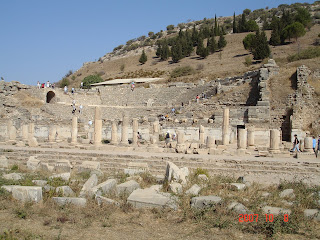



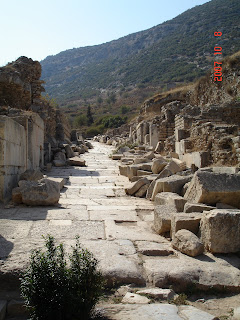



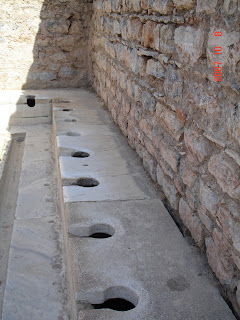


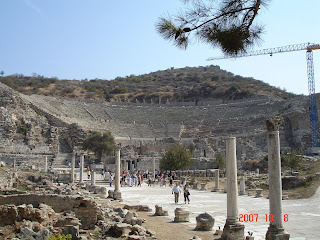
2:00 p.m. – Stopping for lunch. Having all-you-can-eat buffet for $5. The total cost with water will be $8. They really screw you over on drinks here.
2:45 p.m. – Lunch is over. We’re driving to St. John’s Basilica close by. St. John the Divine is entombed under the altar within the ruins. Above the Basilica is a well-preserved fortress (citadel) dating back hundreds of years. It looks practically new.
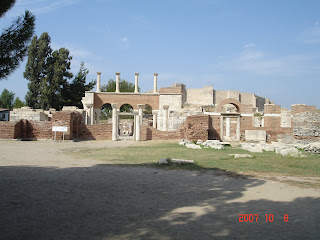





 3:30 p.m. – On our way back to the hotel.
3:30 p.m. – On our way back to the hotel. 6:15 p.m. – Vicki, Vicky, Debbie, Dave and I met for dinner at 5:15 pm then headed down to find a pharmacy. At the pharmacy, the girls stocked up on medications to take back to the US. Some of the prices were the same as US, but the stuff they bought was cheaper. The store closed at 6, but they stayed on till we were done. At the end, they put Vicky’s purchases in a nice bag. Debbie wanted one, so stepped in the door and gave them the evil eye and got one herself. Then they all posed for a hug and photo with the store clerks. Who thought shopping could be this much fun?
6:15 p.m. – Vicki, Vicky, Debbie, Dave and I met for dinner at 5:15 pm then headed down to find a pharmacy. At the pharmacy, the girls stocked up on medications to take back to the US. Some of the prices were the same as US, but the stuff they bought was cheaper. The store closed at 6, but they stayed on till we were done. At the end, they put Vicky’s purchases in a nice bag. Debbie wanted one, so stepped in the door and gave them the evil eye and got one herself. Then they all posed for a hug and photo with the store clerks. Who thought shopping could be this much fun?  8:30 p.m. - We stopped at a local kabob restaurant for dinner. It was quite good. Afterwards, we shopped in the nearby shopping area (books and jewelry) but they were closing. Dave and I stopped at Stavanger Bar for a beer. The girls went back to the hotel. We leave for Antalya tomorrow with a stop in Pamukkle along the way. At the bar, some “girls” knocked on the window while we sat outside wondering if we wanted to join them. There wasn’t time though.
8:30 p.m. - We stopped at a local kabob restaurant for dinner. It was quite good. Afterwards, we shopped in the nearby shopping area (books and jewelry) but they were closing. Dave and I stopped at Stavanger Bar for a beer. The girls went back to the hotel. We leave for Antalya tomorrow with a stop in Pamukkle along the way. At the bar, some “girls” knocked on the window while we sat outside wondering if we wanted to join them. There wasn’t time though. 9:00 p.m. – Back at the hotel packing. 5:30 am wake up call. Good night. Great day.
Day 6 - Tuesday, October 09, 2007 - Pamukkale & Antalya Turkey
Itinerary - Depart Izmir and drive to Pamukkale en route to Antalya. Visit the Necropolis ("large cemetery") and the ancient city of Hieropolis ("Holy City"), situated atop the Pamukkale hot springs, a place considered by UNESCO a World Heritage Site. The Pamukkale hot springs have served as a thermal bath since the 2nd century B.C., primarily for the ailing and old, of which many have retired here.
About Hierapolis: Hierapolis, the “Sacred City,” is located at present-day Pamukkale in south central Turkey. In the first century it was part of the tri-city area of Laodicea, Colossae, and Hierapolis. This connection between the cities lies behind Paul’s reference to Hierapolis and Laodicea in his epistle to the Colossians (Col 4:13). Before 70 AD Phillip (either the apostle or the evangelist) moved to Hierapolis, where he was believed to have been martyred. Hierapolis history goes back to the 6th century BC. At its peak the population reached about 100,000. The ruins at Hierapolis cover an extensive area. The theater, Temple of Apollo, Colonnaded Street, Byzantine Gate, Plutonium and Necropolis (Cemetery) are some of the highlights of the city. The Necropolis has approximately 1,000 tombs and is the largest in Asia Minor.
About Pamukkale: Pamukkale is one of the natural wonders of the world. It is a unique geological formation formed over 14,000 years. The spring water at Pamukkale has therapeutic qualities and since antiquity has been said to cure rheumatism, kidney and heart diseases.
Diary:
5:30 a.m. – Woke up just a few minutes ago, ahead of the 5:30 am wake up call. This is the first night I slept the whole night. We have a long drive day today. We leave Izmir at 7 am, stop in Hierapolis and Pamukkale for an hour along the way, and arrive in Antalya on the Mediterranean coast at 6 pm this evening. It is yet another beautiful day.
7:00 a.m. – I skipped breakfast to type my journal. Have to stay ahead on this while everything is still fresh in my mind. We just left Izmir on our way to Pamukkale, where the gleaming white calcium deposits cascade down the mountainside to create one of the most breathtaking sights in the world. The site needed protection from overdevelopment so UNESCO came in and shut down the hotels alongside the calcium deposits. There are calcium laden pools of water (taverines) that you can wade in and even a pool where you can swim for therapeutic purposes. I’m not swimming, but Vicki, Vicky and Debbie are. Pamukkale means Cotton Castle. Before Pamukkale, we’ll stop at the Hierapolis, which sits above the taverines. It’s an ancient Roman spa dating back to 190 BC. The Hierapolis also contains a Necropolis on the hill stop overlooking the same areas.
9:00 a.m. – Stopped for bathroom break.
9:25 a.m. – Back on the road. We’re traveling up and around the Taurus Mountain range. Very nice views.
10:00 a.m. – Shiites vs. Sunnis – What’s that all about? Islam doesn’t allow sects like we do in Christian religions (Catholic, Lutheran, Methodist …). So Shiites and Sunnis should not exist in Islam. So why do they exist anyway? When Mohammed died, his followers did not know how to carry on. Ali, the nephew of Mohammed thought he should be leader (Kalif – like the Pope) because he was closest to Mohammed. However, an elder (Omar) was elected to take Mohammed’s place and Ali just let it go, biding his time. When Omar died, Ali stepped forward and was once again overlooked as the new Kalif, and even one more time after that until he got upset. Then he pulled all the political stops to get elected as the 4th Kalif, leveraging his family ties to Mohammed and family influence elsewhere. He was elected but many did not like Ali. This is when politics entered Islam. Those who did not like him called him a troublemaker, a Shi’a. He went on to conquer Damascus and parts of what is now Iraq. They became known as Shiites, with the rest of the Muslims being known as Sunnis—followers of Mohammed. Those who succeeded Ali (Shiites) as the head of the Shiites were known as Imams. The next 12 Imams after Ali were assassinated. Today they bomb each others’ mosques. It’s all political today, like Republicans vs. Democrats. It’s not religious.
There are 25 million Shiites in Turkey. They are the fundamentalists. Iran is mostly Shiite. Iraq is mostly Sunni. If the US splits Iraq into three parts (Kurds, Sunni and Shiites) to stop the fighting, the Shiites will join Iran and that will be bad, since Iran is the enemy of Turkey.
1:30 p.m. – We’ve arrived in Pamukkale. The area was first settled in 400 BC. We stopped at the Necropolis, a vast cemetery comprised entirely of sarcophagi as far as the eye can see. All have been looted over the centuries. It’s pretty interesting.




MY CAMERA BROKE. Using Dave’s camera to take pictures. Same problem as my old camera—the lens motor won’t retract the lens.

 1:45 p.m. We stopped on the road beneath the taverines for a photo of the calcium-deposit laded cliffs gleaming in the sun. Looks quite surreal. We then drove up the mountain to the top where there is a pool and where it overlooks the cliffs. We waded in the pools of water on the cliffs. The surface was kind of sharp. Bad for my heal spurs. But the view was breathtaking. Lots of tourists (fat Russian ladies in bikinis and Speedo men). We stopped for photos then went to the pool. Vicki, Vicky and Debbie are enjoying a swim in the pool while Dave and I have a beer.
1:45 p.m. We stopped on the road beneath the taverines for a photo of the calcium-deposit laded cliffs gleaming in the sun. Looks quite surreal. We then drove up the mountain to the top where there is a pool and where it overlooks the cliffs. We waded in the pools of water on the cliffs. The surface was kind of sharp. Bad for my heal spurs. But the view was breathtaking. Lots of tourists (fat Russian ladies in bikinis and Speedo men). We stopped for photos then went to the pool. Vicki, Vicky and Debbie are enjoying a swim in the pool while Dave and I have a beer. 



 2:00 p.m. Taking a walk around the pool area to admire the ruins of the Roman Spa and Theater of Hierapolis.
2:00 p.m. Taking a walk around the pool area to admire the ruins of the Roman Spa and Theater of Hierapolis. 


2:30 p.m. – Having a few photos taken before we leave Pamukkale. Then off to lunch.
4:50 p.m. – Everyone is sleeping. It’s been a long ride today. We arrive around 6 pm.
5:00 p.m. - People are asking about cars in Turkey. Back in the 50s and 60s, people in Turkey had one car per neighborhood that people used as needed. Now they have 1.2 per household. All cars are made here—and all car companies have factories here (Toyota, Ford…). People must have car insurance here, but when you have an accident, you don’t call the police unless there’s a fatality. You never file a claim because you don’t want your premiums to go up. You just argue, settle, and move on.
5:10 p.m. - Wages in Turkey? Minimum is $500 per month. People don’t have savings accounts here so they basically spend everything they make. Interest is also forbidden in Islam. People get by because they don’t go out to eat or stay at expensive resorts when they vacation. But everyone has a cell phone even though they are expensive. TVs came in the early 1970—all black and white—to televise the Olympics. They watched Dallas and The Fugitive back then and people were glued to their TVs. There was one TV for several homes. Now everyone has a satellite dish. People have even better refrigerators than in the US. They replace them every two years—highly coveted. The refrigertors even tell you when you’re running out of eggs.
5:15 p.m. - Every neighborhood has a mochtar (ombudsmen) who is the lowest paid elected official. He knows everyone in the neighborhood and handles all affairs between you and the government. He approves your welfare money by paying a visit each week to see how you are doing and checks your job hunting status.
5:15 p.m. – We’re here in Antalya. Population is 750,000-800,000 in the summer and half that the rest of the year. Very popular resort area on the Mediterranean. Lots of Germans and Russians come here. The city is a huge natural egg-shaped harbor surrounded by mountains.
5:20 p.m. - Crime in Turkey. It exists but is very low. There is no jury. Your fate is determined by a panel of judges. OJ wouldn’t last 10 minutes in a Turkish jail. You are innocent until proven guilty except where rape and child molesting is concerned. Every neighborhood has a watchman who keeps an eye on things, usually an old man living in the neighborhood.
The country is pretty drug free right now. But Turkey is the biggest drug trafficking country in Europe. Drugs come from Afghanistan and other parts of Asia. If can’t get the drugs through Turkey, the only alternative is Siberia. Most drugs flow by truck through Turkey to Bulgaria. Then, if you can get them through Germany to Holland, Turks in Holland will sell them on the street. Trafficking drugs is a capital offense in Turkey. But drug use is almost nonexistent amongst the Turks. Turkey created the fastest boats in the world to run down traffickers on the water. But the traffickers just sink their boats to avoid being caught.
To show how low crime is, you should know that people don’t have savings accounts. Women wear their wealth as gold bangles around their wrists. If crime were high in Turkey, women would have no arms because robbers would cut them off to get her wealth.
5:25 p.m. - Turkey and the EU – Turkey trying to get into EU. But EU doesn’t want them. Turkey made all the reforms demanded by EU but still not in. EU says there are still issues with Greece and Armenia to resolve. Turkey has slowed down reforms until the EU comes through.
6:00 p.m. – We’re at hotel. Very nice. Posh.


10:00 p.m. - Beautiful weather. Great view of harbor and mountains from my room. Had dinner out on the terrace. All you can eat buffet. Had a few drinks afterwards. Lots of stray cats roaming around the property. Not allowed to feed them.
10:30 p.m. - Free Internet at hotel in all rooms. Time for bed.
Day 7 - Wednesday, October 10, 2007 - Antalya, Perge & Aspendos, Turkey
Itinerary - Full Day Tour to Perge, Aspendos & Antalya Archaeological Museum - Drive to Perge, a Pamphylian city. Perge was founded between BC12-13. It is the most attractive and well preserved Pamphylian city. The ancient theater, stadium, towers, Agora, Acropol and the Palaestra which is given to Imperial Claudius are the highlights of the ancient city. Continue to Aspendos, founded in BC 4-5 by the colonists from Argos. Though it is well-known for its theater with a capacity of 30,000 people, the city also boasts a stadium and a fountain. All the ruins in the city have remained from the Roman period and the theater is still being used for contemporary concerts. Later, return to Antalya and visit the Antalya Archaeological Museum which houses artifacts and antiques from 2,500 years of Anatolian culture.
About Perge: Now just ruins, Perge was a very ancient town. Greek colonists came here after the Trojan War, probably displacing earlier inhabitants. Perge prospered under Alexander the Great and the Romans, but dwindled under the Byzantines before being abandoned.
About Aspendos: Aspendos is located in the ancient region of Pamphylia. According to some experts the earliest settlers of the city were the Hittites. The name Aspendos is of Anatolian origin. The Greek colonies arrived here around 13th century BC and took over an existing settlement. Alexander the Great claimed the city from the Persians and during the Roman period it was an important port city. The city was founded on a hilltop and spread down to the plains. Aspendus has one of the best preserved and largest Roman theaters in Turkey. It was built in the 2nd century AD. The city's aqueducts are also well preserved and worth a visit.
Diary:
6:45 a.m. – Beautiful day. My hotel overlooks the Mediterranean Sea. Got up just before the 7 am wake-up call. Miraculousy, MY CAMERA IS WORKING AGAIN!.
8:30 a.m. – Taking the optional tour to Perge, Aspendos and the Antalya Archeological Museum. The girls are staying behind to sleep in, go to the spa and shop.
 8:45 a.m. – We’re in Perge. Perge is 9 miles east of Antalya. It contains the ruins of an ancient city first settled by the Greeks after the Trojan War some 2,000 years ago. It prospered under Alexander the Great but dwindled under the Romans, who eventually abandoned it.
8:45 a.m. – We’re in Perge. Perge is 9 miles east of Antalya. It contains the ruins of an ancient city first settled by the Greeks after the Trojan War some 2,000 years ago. It prospered under Alexander the Great but dwindled under the Romans, who eventually abandoned it.




 10:30 a.m. – Perge was very interesting. It has a huge theater, stadium, Roman and Hellenistic Gates, Roman baths, a huge main street and market (agora). The stadium was U-shaped and used for track and field events. Later it was used for gladiator fights and lions. We passed through the Roman gates and into the Roman baths. You could see the brick furnaces where they used to heat water. Bellows were then used every hour or so to blow the steamy air throughout the bath building. The main street was lined with pillars and once had a canal with cascading water flowing right down the middle. You could even see the chariot wheel ruts in the roads leading up and down the main street. The girls missed a good site.
10:30 a.m. – Perge was very interesting. It has a huge theater, stadium, Roman and Hellenistic Gates, Roman baths, a huge main street and market (agora). The stadium was U-shaped and used for track and field events. Later it was used for gladiator fights and lions. We passed through the Roman gates and into the Roman baths. You could see the brick furnaces where they used to heat water. Bellows were then used every hour or so to blow the steamy air throughout the bath building. The main street was lined with pillars and once had a canal with cascading water flowing right down the middle. You could even see the chariot wheel ruts in the roads leading up and down the main street. The girls missed a good site. 11:00 a.m. – We are on our way to Aspendos to see the best preserved theater in the country. It is still in use today and seats some 30,000 people. Aspendos is a few miles east of Perge. We passed sesame fields. They contained bundles of sesame, which grows like a weed. You can crack the husks to get at the seeds which are then crushed to make a paste like peanut butter that you can spread on bread or mix with other ingredients to make tahini sauce.
11:00 a.m. – We are on our way to Aspendos to see the best preserved theater in the country. It is still in use today and seats some 30,000 people. Aspendos is a few miles east of Perge. We passed sesame fields. They contained bundles of sesame, which grows like a weed. You can crack the husks to get at the seeds which are then crushed to make a paste like peanut butter that you can spread on bread or mix with other ingredients to make tahini sauce.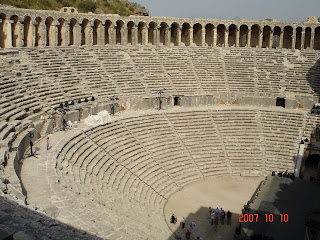 12:00 p.m. – We just finished touring the theater at Aspendos, a town that dates to 800 BC to the Hittite Empire. The Greeks fought the Persians here in 468 BC. The Greeks won. The theater was built by the Romans in 161-80 BC. When Ataturk visited the theater, he thought it was so beautiful that he ordered it restored. I climbed way up to the top. The acoustics were so good that even way up at the top I could here our Tour Director talking down at the stage.
12:00 p.m. – We just finished touring the theater at Aspendos, a town that dates to 800 BC to the Hittite Empire. The Greeks fought the Persians here in 468 BC. The Greeks won. The theater was built by the Romans in 161-80 BC. When Ataturk visited the theater, he thought it was so beautiful that he ordered it restored. I climbed way up to the top. The acoustics were so good that even way up at the top I could here our Tour Director talking down at the stage. 12:30 p.m. – We’re on our way to the Antalya Archaeological Museum, which was voted the best museum in Europe last year. Many of the items in the museum were brought here from Perge.
12:30 p.m. – We’re on our way to the Antalya Archaeological Museum, which was voted the best museum in Europe last year. Many of the items in the museum were brought here from Perge.1:30 p.m. -The museum was great. I never take pictures in museums, but this was an exception. It was very well laid out. The museum houses items from the Stone and Bronze ages, then the Hellenistic periods. The Hall of the Gods has statues of 16 classical gods from Aphrodite to Zeus. The next room contained very intricate sarcophagi from the second century AD. One room has the skull and bones of St. Nicolas in the Christian section. The last room contains artifacts from the more recent Ottoman Empire.
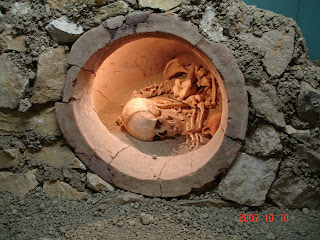




 2:00 p.m. - The tour bus went through downtown Antalya so Dave and I got off and walked around.
2:00 p.m. - The tour bus went through downtown Antalya so Dave and I got off and walked around. 

3:00 p.m. - We walked down to the Roman Harbor. There were several shops, restaurants and hotels. When we got to the bottom, we stopped for a beer. It was very hot so the beer was more than welcome. After that, we hiked back up the hill, took some photos of the brick minaret at the mosque along with pictures of some other old structure. We then walked through the shopping area. Eventually, we grabbed a $10 cab back to the hotel to take in some swimming in the Mediterranean before we leave tomorrow.
 5:00 p.m. – We had a wonderful swim in the sea. We ran into Vicki, Vicky and Debbie on their way back from the spa, where they got the complete program consisting of a sauna, thorough scrub down and massage. They’re raving about it.
5:00 p.m. – We had a wonderful swim in the sea. We ran into Vicki, Vicky and Debbie on their way back from the spa, where they got the complete program consisting of a sauna, thorough scrub down and massage. They’re raving about it. 

 After the sauna, you go into an ice room that is filled with snow and very cold. This cools you down and closes the pores. You are then taken to a room and covered in bubbles and had the full body scrubbing. This is done in the buff. They had a couple of guys working them over. After that you get the massage. Sounded nice. (After dinner, Vicky took me down to the spa room for the grand tour. Kind of wished I would have gone.)
After the sauna, you go into an ice room that is filled with snow and very cold. This cools you down and closes the pores. You are then taken to a room and covered in bubbles and had the full body scrubbing. This is done in the buff. They had a couple of guys working them over. After that you get the massage. Sounded nice. (After dinner, Vicky took me down to the spa room for the grand tour. Kind of wished I would have gone.)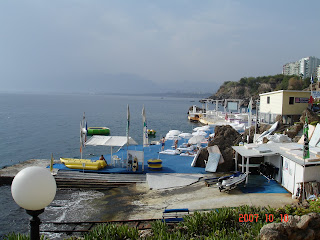 Down at the beach, we swam around. They had a floating trampoline out in the water. I put my swim goggles on and noticed a lot of small fish swimming below. Afterwards, we stopped at the pool to talk to the Green Bay group. Then I went up to shower.
Down at the beach, we swam around. They had a floating trampoline out in the water. I put my swim goggles on and noticed a lot of small fish swimming below. Afterwards, we stopped at the pool to talk to the Green Bay group. Then I went up to shower.6:00 p.m. – I’m back down at the beach with the Green Bay group taking turns drinking lukewarm vodka and lemonade out of a plastic bottle.
6:30 p.m. – Having a beer with Dave out on the terrace. Nancy and Sue from our group came over to chat. They are pretty well traveled.
7:30 p.m. – Having dinner downstairs in the hotel restaurant again. They have live music tonight. Nice little band.
10:00 p.m. – Vicky was just up having me download her pictures onto my computer. She also showed me her family tree on Ancestry.com. She’s done a lot of work on it. Now I know why I haven’t seen the video from Thailand/Cambodia yet.
Time for bed. We have a 5:30 am wake up call and leave for Cappadocia tomorrow. Another long day on the bus.
Day 8 - Thursday, October 11, 2007 - Kaymakli & Nevsehir, Turkey
Itinerary - Travel to Cappadocia and visit the 13th century Caravanserai of Agzikarahan (caravan palace) en route, a large underground city and shelter in Cappadocia, built on the Silk Road, whose main portal gate is considered a fine example of Turkish Seljuk art. During the Seljuk period, trade was a flourishing industry, an industry which needed roads for caravan transport and inns for the traveling traders. The Caravanserai provided these traders, both foreign and native, with heated rooms, food, medical attention, equipment repair and many other common conveniences. There was even a small mosque, known as "Kosk Mescid," in the courtyard's center where the travelers could conduct religious practices. Continue to Nevsehir in Cappadocia.
Diary:
4:30 a.m. – Woke up early today. Watching the news as the US House of Representatives passes a resolution to condemn Turkey for World War I atrocities against the Armenians, calling it mass genocide. Timing couldn’t be worse because much of what our soldiers need in Iraq flows through Turkey, such as gasoline, food and supplies, as well as access to Turkish military bases. If the Senate now passes the bill, Turkey will cut us off.
Meanwhile, 15 Turkish soldiers have been killed by Kurdish militant attackers just north of the Iraqi border in southern Turkey. Turkey is massing troops and hardware on the border of Iraq to retaliate. The US and Iraq urged Turkey to avoid military action, which they fear could destabilize the whole region, and to fight the outlawed Kurdistan Workers Party (PKK) by diplomatic and other means. But the Turkish government is under heavy domestic pressure to act after a series of deadly PKK attacks on Turkish troops. So, Turkey's parliament authorized troops to cross the mountainous border into northern Iraq to track down rebels, who use the region as a base from which to attack Turkish targets. The Baghdad government has little clout in the mainly Kurdish autonomous region of the north. Turkey remains reluctant to take military action because of the security, economic and diplomatic risks. But the parliamentary authorization is useful because it keeps the rebels guessing and also increases pressure on the US and Iraq to take their own action against the PKK. Turkey blames the PKK, which the United States and the European Union also brand as a terrorist group, for the deaths of more than 30,000 people since the rebels launched their armed campaign for an ethnic homeland in southeast Turkey in 1984.
7:00 a.m. – Had another 5:30 am wake up call, but I was already up. We just left the hotel after our breakfast. Debbie stole a pillow from the hotel so that I would be more comfortable sleeping on the bus. Thanks Debbie. It is more comfortable.
7:15 a.m. – Salih is telling us about the Turkish-Armenian issue since it is front page news. Turkey has known that the US resolution condemning them for WWI atrocities was coming. All the major countries around the world have passed one over the years. The US is the last major power to do so. Since they support us in Iraq, the timing is very bad.
Armenia is one of the oldest civilizations in the area. They are the “Children of Armen,” an ancient leader. They established the first Christian state, even before the Romans. They are Gregorian (orthodox Christians). Armenia borders Turkey on the east near Mt. Ararat and Russia on the west. Armenia lost power long before the Turks entered the area. The Romans entered the area and took them over. Then the Ottomans took over in the 13th century. Everything was fine under the Ottomans until the Ottoman Empire started to collapse in the early 1900s. When the Ottomans sided with the Germans in WWI, the Russians and French approached the Armenians and got them to join their side. The Russians promised the Armenians their own land back—their former kingdom. At the time, the Turks had enough problems on their hands and the Armenians joining the Russians was a real threat to the Turkish government. So, like the American Indians who were relocated in the US, the Turk government relocated the Armenians to the south of the country. This was after the Armenians attacked a village in Turkey and killed all the people, including the pasha’s family. Turkey rounded up all the Armenian militants and killed them. As the Christian Armenians headed south towards the Syrian border, the Muslim Kurds attacked and killed them along the way. Armenia claims 1.5 million people were killed in all. They call it genocide, but the Turks refuse to call it that. After the war, the Turk soldiers were returning home and the Armenian army blocked the roads and trapped them in a frigid area where 80,000-90,000 Turk soldiers died in the cold. At the same time, the Armenians went on a worldwide offensive and killed Turkish diplomats all over the world to call attention to the genocide against them earlier. The Armenian violence against Turks stopped 25 years ago and the Armenians are now using political influence to call attention to the situation. Many Armenians live in California and also in France where they continue to exert influence to get foreign countries to condemn Turkey for what the genocide in 1915. Now I understand why Democratic Congresswoman and Speaker of the House Nancy Pelosi is championing this in Congress. The US debated the Turkey-Armenian issue in 1980, but it went no where. Only now are they reconsidering it. The issue is that Armenia wants the situation to be called genocide. The Turks will never agree to it. Without the genocide label, Armenians will be assimilated and forgotten as a people. Having the label will give them an identity.
8:30 a.m. – Driving through the mountains. Very pretty. It’s a nice day.
9:15 a.m. – Had our bathroom and rest stop. For once, we are the first bus at the stop, not the last one. Our bus got stopped just after the rest stop. The guard asked the driver for an electronic card that has information about the bus’s speed. If the driver has been speeding, he gets a ticket. If he gets more than three, he could lose his license. We passed without incidence.
9:20 a.m. - We’re discussing Whirling Dervishes. A dervish is a monk. They originated in Konya, Turkey back in 1200 when Konya was the capital of the Empire that existed just before the Ottoman Empire. The monks and the leader of that Empire believed in love and tolerance and that everyone should reach to God during their life time. The whirling dance of the dervishes is intended to symbolize reaching up to God’s level while still among the living. The dervishes whirl in a circle for 20-30 minutes straight. They keep one foot planted on the ground and spin themselves with the other. They wear a white costume representing a shroud and a white pointed hat representing a tombstone. The dervishes say that the whirling lifts you up to God and is the same as experiencing death while alive. They hold one hand in the air to represent the receipt of God’s blessing and the other down representing the passing of the blessing to those who are in need of it. This is a philosophy, not a religion.
The Dervish sect was outlawed by Prime Minister Ataturk because he feared their powerful influence would sidetrack efforts to secularize the country. It is illegal to join the sect now since it has been shut down. They are allowed to practice and often perform at the government’s request for visiting dignitaries. There are about 200-300 male whirling dervishes in Turkey and two female dervishes, one of whom is an American living in Istanbul who teaches English as a second language. Some of the group (not me) are going to a performance tomorrow tonight. There is no applause at the start or end of a dervish dance. Hope they remember that.
10:00 a.m. – We’re talking about the Kurds. I didn’t get all this down, but the situation is a mess. The Kurds have been around since Mesopotamia—a long time. They have never been treated well by anybody. They have never had their own state. You could give them a state in Iraq, but they would be landlocked on a mountain top with no water, access to ports, or natural resources. There are 27 million Kurds in Turkey. 63% of the Turkish military are Kurds, so they could easily take over the country if they wanted to. There are also 4 million in northern Iraq. Saddam Hussein henchman Chemical Ali bombed the Iraqi Kurds for refusing to join Saddam in his war against Iran in the 1980s. 50,000 injured Kurds came to Turkey for treatment for their burns.
The Kurds (not the PKK militants) in northern Iraq are our allies (along with the Sunnis from the south). Before the Gulf War of the early 1990s, the US was hoping the Kurds and Sunnis would unite and oust Saddam Hussein. But he escaped in a helicopter and then ordered his troops to annihilate the Kurds. The Kurds called Bush Sr. and he came in with UN to establish a no-fly zone in northern Iraq to protect the Kurds.
Today the Kurds are our allies in the Gulf War. There is a militant branch called the PKK Kurdish Liberation Army that is located in northern Iraq and attacks Turkey everyday. Many Turkish soldiers have been killed by these attacks. This week alone, 15 have been killed and the Turkish people are now demanding action. The US is asking Turkey to resolve the matter diplomatically. Having Turkey and the Iraqi Kurds as allies makes the situation tense for us because we want to avoid having Kurds fight Kurds since it could destabilize our efforts in Iraq.
 12:15 p.m. – Stopped for lunch. Vicky and Debbie were ogling some Turkish guy at the restaurant. But he lit up a cigarette and blew his chances with them. Our lunch stop was in Konya, the most conservative city in Turkey. Despite this, they drink more raki than any other town. Many of the women still wear burkas. Fundamentalists used to be politically in control of the town, but they were voted out of office now. In Turkey, you can vote at 18 and seek public office at 25. To drink or drive, you must be 21.
12:15 p.m. – Stopped for lunch. Vicky and Debbie were ogling some Turkish guy at the restaurant. But he lit up a cigarette and blew his chances with them. Our lunch stop was in Konya, the most conservative city in Turkey. Despite this, they drink more raki than any other town. Many of the women still wear burkas. Fundamentalists used to be politically in control of the town, but they were voted out of office now. In Turkey, you can vote at 18 and seek public office at 25. To drink or drive, you must be 21. 1:30 p.m. – We stopped 10 miles northeast of Aksaray to visit Caravanserais Agzikara Hani, which was built between 1231 and 1239. A caravanserais (or caravansary in English) is a large fortified way station for caravans. This was used in the old days as a stopping point for trade caravans along the Silk Trail linking Europe to China.


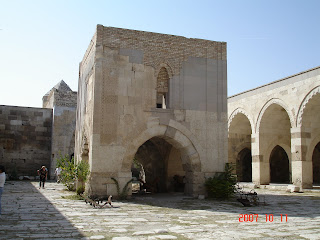
2:30 p.m. – We’re in the state of Cappadocia, which means “Land of Beautiful Horses.” 5 phrases describing the area: 1) Volcanic mountains – There are two: Mount Hassan and Mount Argos. 2) Ashes and eruptions – The volcanoes erupted millions of years ago, leaving soft basalt deposits all over the area known as tufa. 3) Erosion—The tufa erodes away easily by wind and rain. Mushroom head formations are quite common. 4) Hittites—They first settled here and carved out the tufa for wine cellars. 5) Underground Cities—After the Hittites, the Persians and then Romans came into the area. The Romans created the cave dwellings.
 4:00 p.m. - We are in Nevsehir (Nyssa in the Bible), a city in Cappadocia, visiting a former underground city called Kaymakli that once housed 4,000 people. There are at least 36 such cities, the largest of which housed 16,000 people. The people who lived here sought refuge underground from temperature extremes in the area (it can get down to -22ºF in the winter). Kaymakli extends several levels underground.
4:00 p.m. - We are in Nevsehir (Nyssa in the Bible), a city in Cappadocia, visiting a former underground city called Kaymakli that once housed 4,000 people. There are at least 36 such cities, the largest of which housed 16,000 people. The people who lived here sought refuge underground from temperature extremes in the area (it can get down to -22ºF in the winter). Kaymakli extends several levels underground. 


 The stone inside the caves is so soft that the inhabitants could carve it with hand tools or their bare hands. All of the underground cities had secret entrances. When attacked, the people could go lower and deeper into the maze of underground tunnels to escape, sometimes a mile away to another underground city. The tunnels are narrow so they used a millstone with a hole in the center to block the tunnel and make their escape. Then they could tell the other city that they were under attack. Each city was truly self sufficient.
The stone inside the caves is so soft that the inhabitants could carve it with hand tools or their bare hands. All of the underground cities had secret entrances. When attacked, the people could go lower and deeper into the maze of underground tunnels to escape, sometimes a mile away to another underground city. The tunnels are narrow so they used a millstone with a hole in the center to block the tunnel and make their escape. Then they could tell the other city that they were under attack. Each city was truly self sufficient. The caves are a constant 64ºF in summer and winter. If cold, you could heat an area with only 4 candles. They also had perfect air circulation, with fresh air being fed into the underground city by ventilation tubes that could extend down up to 120 yards.
Our tour took us down four levels below ground. The tunnels were narrow and dark. You also have to crouch down low because the tunnels are only 4 feet high. Some members of the group were claustrophobic or had difficulty walking on uneven surfaces, so stayed behind with Salih as a local guide took us through the tunnels. The passageways were barely wide enough for someone to pass through. I took a picture of Vicky’s rear end to show how narrow and squat the tunnels were.
 4:55 p.m. - I bought a Turkish hat to wear with my Halloween costume.
4:55 p.m. - I bought a Turkish hat to wear with my Halloween costume.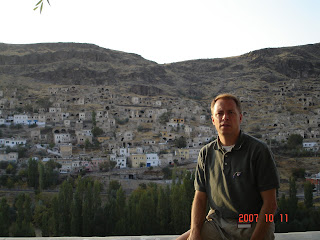 5:00 p.m. – We have just driven 5 minutes from our last destination and are now on a scenic overlook across from a town that was built into the hillside. It looks like adobe buildings. We posed for pictures, including several with the local kids who were hanging out where the tour busses stop. Nice views.
5:00 p.m. – We have just driven 5 minutes from our last destination and are now on a scenic overlook across from a town that was built into the hillside. It looks like adobe buildings. We posed for pictures, including several with the local kids who were hanging out where the tour busses stop. Nice views.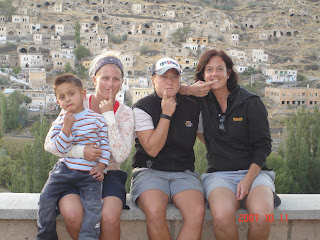
5:30 p.m. – We are at the Peri Hotel, our home for the next two days. The hotel has an odd, award winning layout patterned after the underground cities in Cappadocia. It has several different wings that wind up and down around the hotel. I have a nice room with a huge deck overlooking the pool.
7:15 p.m. – Had some cocktails out on the deck with the Green Bay group. We are going to dinner now, which is (surprise) a buffet.
8:00 p.m. – Hooking up to the Internet to send this up to my blog. I'll then have a few beers. See you tomorrow.
Day 9 - Friday, October 12, 2007 - Kaymakli, Nevsehir & Avanos, Turkey
Itinerary - Full Day Cappadocia - Visit the Open Air Museum in the Goreme Valley to see the early Christian churches decorated with unique frescoes depicting various scenes from the Bible. Then visit the village of Avanos that is famous for its beautiful old houses, pottery, carpets and onyx.
About the Cappadocia Region:One of the geological wonders of the world. Cappadocia is a high plateau in Central Turkey at an altitude of 3,270 ft/1,000 m. It lies in a triangle formed by the three main towns of Kayseri, Nevsehir and Nigde. The history of Cappadocia begins 60 million years ago with the eruption of 2 volcanos, covering the area with lava and tufa. In later periods rain and wind eroded the land and created unusual valleys, canyons and cones. For many centuries Hittites, Assyrian Colonies,Greeks and Romans lived in the region. Cappadocia is also a very important region in early Christian History. There are over 600 hundred rock-cut churches built by monks and hermits between the 4th and 11th centuries. In some of these, church walls have been decorated with wonderful frescoes depicting scenes from the Bible.
Diary:
8:30 a.m. – Another gorgeous day. We haven’t had any bad weather this entire trip. It is a bit cooler here than the other places we’ve stayed, and the forecast is calling for cooler temperatures for the remainder of the trip. A lot of people are wearing long pants today.
Everyone seems to be having shower issues this morning. The shower in our bathrooms is a really unique and dangerous design. It’s like a mini-bathtub but has a step in it that you could sit on if you wanted to take a bath. Otherwise, you have to step down onto a postage-stamp sized area. It was dangerous getting out of because you have to climb up the slippery step. And there is no handle to grab onto.
My wake-up call was the 5 am call to prayer, which was broadcast over a loudspeaker over the entire city. But I slept well so it didn’t bother me too much. I went to the lobby at 6 am to hook up to the Internet for 1-1/2 hours before breakfast. There was nobody there so I just switched on a few lamps and plugged away until the hotel staff came on duty a half hour later.
8:35 a.m. – It’s the day after Ramadan ended, so it’s a three-day holiday here in Turkey. That means none of the tourist sites are open till 1 pm. So we’re going to drive around all morning in the Goreme Valley taking photographs. The Muslim population no longer has to fast, so they have a sort of trick-or-treat for the kids and then the families get together to feast all day. Tomorrow, families will visit friends, but today is family day, so we’ll see a lot of people on the road and all the places we will be visiting today. The bus driver’s assistance is passing out candy on the bus to get us in the Turkish holiday mood.
Our hotel is in the city of Nevsehir, which is a very modern city. There is a lot of new construction going on. The town is basically a tourist town catering to tourists visiting the underground cities in the area.
9:00 a.m. – We’ve stopped at Zemi Valley for pictures of the tall, tepee-shaped tufa domes and hot air balloons in the distance. Cool. Vicki bought a large blue/green tablecloth with lots of mirror decorations sewn into it. A lot of other people made purchases as well. Up until now, no one has really spent any money on souvenirs. But with pent up demand, this could be a banner day for local businesses.

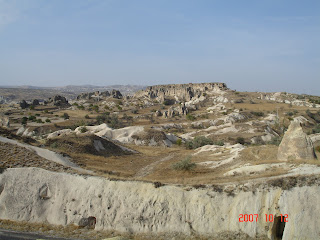 We’re driving out in the countryside, which has a spooky, moonscape like appearance. You can see hot air balloons in the distance. We’re going on them tomorrow. Looks like fun.
We’re driving out in the countryside, which has a spooky, moonscape like appearance. You can see hot air balloons in the distance. We’re going on them tomorrow. Looks like fun.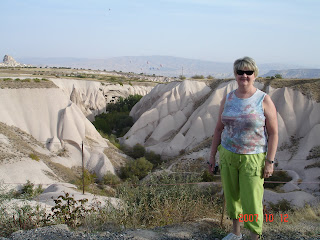
9:30 a.m. - We’re in the town of Ürgüp. The wind and rain erosion has created some interesting rock formations. There are a lot of tall pillar-like rocks with big rocks perched on top of them.
 It almost looks like they used a crane to hoist those rocks on top of the pillars. Vicki bought some small, locally made dolls for her nieces. Debbie bought some cashmere scarves.
It almost looks like they used a crane to hoist those rocks on top of the pillars. Vicki bought some small, locally made dolls for her nieces. Debbie bought some cashmere scarves.10:00 a.m. – OK, we’re at stop number 3. We’ve stopped to take pictures of some rock formations that look like camels.


We’re at 3,500 feet so we could get a little short of breath.

There are a million tour busses. Vicki went to the bathroom behind some rocks and discovered a pen with some baby puppies.
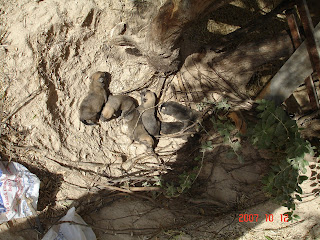
The group continues to pump more money into the local economy.
Vicky is hot and asking for the A/C to be cranked up. You don’t want to deal with Vicky when she is hot. Salih complied with her request. Vicki, Vicky and Debbie had a lot of problems with the A/C at the hotel in Antalya and had technicians in their room trying to fix it at 10:30 pm.
Vicki bought a Burberry poncho. Vicky bought a pink cashmere scarf. Debbie bought a “damn doll” that Vicky shamed her into buying.
10:05 a.m. – We’re in the bus heading through the moonscape valley. We’re on our way to Avanos to go to a pottery store. The area we’re traveling in has been used in the past to film science fiction movies and westerns. There are also a lot of wineries in the area.
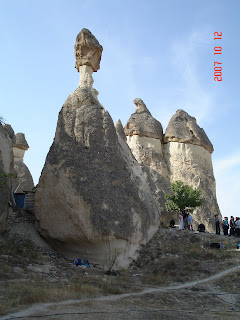 10:30 a.m. – We’ve stopped at the Zelve Open Air Museum for more photos. There are tons of mushroom cap rocks that you can climb up and into. Also, lots and lots of shopping. Vicki bought a table cloth. Vicky bought 6 pumus stones, tons of glass bead necklaces and three hand-painted ceramic bowls. Dave bought a toilet break for 50 Turkish Lira.
10:30 a.m. – We’ve stopped at the Zelve Open Air Museum for more photos. There are tons of mushroom cap rocks that you can climb up and into. Also, lots and lots of shopping. Vicki bought a table cloth. Vicky bought 6 pumus stones, tons of glass bead necklaces and three hand-painted ceramic bowls. Dave bought a toilet break for 50 Turkish Lira. 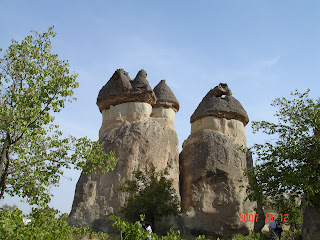

10:45 a.m. – We’re almost to the pottery store in Avanos. They will show us how the pottery is made and then turn us loose in the shop. If we turn a piece of pottery over and it says simply “100,” that means $100 for Americans, 100 Euros for Europeans or 100 Turkish Lira for the locals. Dollars will be our currency of choice.
11:45 a.m. – OK we’re done at the pottery store. It was called Kaya Keramik Evi. They make very expensive pottery that is painted by hand or stencil. We watched how the entire process of making a pot or plate was done. The best part was when they got a lady from our group to sit at the foot-operated potters wheel and make a pot for us. We all howled when she formed a claylike object that resembled a phallic object and stroked it up and down.
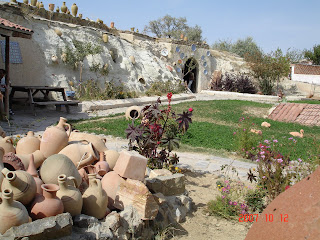
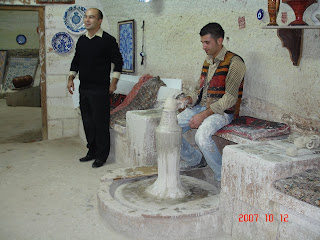

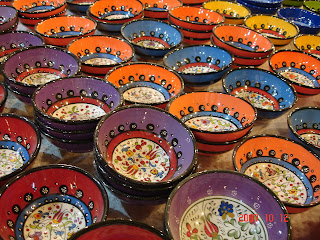
Vicki bought 2 hand painted plates. Vicky bought a small plate. I’m empty handed again.
12:00 p.m. – We’re going to a carpet store to learn how hand woven carpets are made. The rugs made in Turkey are amongst the world’s finest. But they are not cheap. The rugs are made by women in their homes in the areas villages. There are over 4,000 looms in the area.
12:10 p.m. – We’ve arrived at the Yukel Hali carpet store for a demonstration of Turkish rug making and lunch. It’s odd to have a store serve you lunch.
 2:00 p.m. – We spent two hours shopping for rugs. Several people in the group made purchases. I’m estimating the store grossed more than $10,000 from us. Vicky bought 3 rugs. They got us in the mood for buying rugs by providing lunch consisting of Turkish pizza and our drink of choice—soda, water, Turkish coffee, raki, wine or beer.
2:00 p.m. – We spent two hours shopping for rugs. Several people in the group made purchases. I’m estimating the store grossed more than $10,000 from us. Vicky bought 3 rugs. They got us in the mood for buying rugs by providing lunch consisting of Turkish pizza and our drink of choice—soda, water, Turkish coffee, raki, wine or beer. 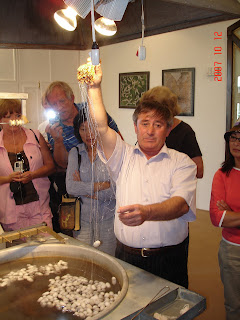

The most interesting part of the tour was the way they soaked silk cocoons in hot water to soften them up then use this machine to unravel the cocoons and create silk thread.
 The carpet demonstration was pretty typical. The group sat along the perimeter of this large room. Then they put rolled up carpets on the floor and push them towards you. Most people think the rug is going to hit them as it unrolls, but it always stops just before that happens. I chuckled as the Green Bay group flinched as the unfurling carpet got closer and closer to their feet.
The carpet demonstration was pretty typical. The group sat along the perimeter of this large room. Then they put rolled up carpets on the floor and push them towards you. Most people think the rug is going to hit them as it unrolls, but it always stops just before that happens. I chuckled as the Green Bay group flinched as the unfurling carpet got closer and closer to their feet.  They unrolled about 75 carpets of all shapes and sizes and then asked us to point out the ones we were interested in. Then they took you to private showrooms where a salesman tried to sell you the carpet. A lot of the carpets were “on sale” today. I went with Vicki to her private showroom. But I left after 20 minutes when I realized it could take all day and that they were not really showing her what she wanted at a price she was willing to pay. I sent Vicky back to help Vicki extricate herself from the high pressure sales pitch. They wanted $4,900 for 3 rugs, but Vicki would only pay $3,300-$3,400. In the end, she struck a deal and got all three.
They unrolled about 75 carpets of all shapes and sizes and then asked us to point out the ones we were interested in. Then they took you to private showrooms where a salesman tried to sell you the carpet. A lot of the carpets were “on sale” today. I went with Vicki to her private showroom. But I left after 20 minutes when I realized it could take all day and that they were not really showing her what she wanted at a price she was willing to pay. I sent Vicky back to help Vicki extricate herself from the high pressure sales pitch. They wanted $4,900 for 3 rugs, but Vicki would only pay $3,300-$3,400. In the end, she struck a deal and got all three. 2:45 p.m. – The Goreme Open Air Museum is still too crowded, so we’re going to drive around and take pictures a little longer.
3:15 p.m. – We stopped at Avcilar Valley to photo more teepee-shaped mountain dwellings and shop. There’s a real pattern developing here. We even had ice cream cones—lemon, chocolate or vanilla. Vicki bought a hand painted plate that was much cheaper than the pottery store, and some small, colorful ceramic bowls for her daughter. Vicky also bought some colorful ceramic bowls. I’ll wait till the Grand Bazaar in Istanbul to buy some of those.
3:30 p.m. – OK, we’re finally on our way to Goreme Open Air Museum, a UNESCO World Heritage Site that was first inhabited in 400 AD. It is an old Christian Monastery carved out of the mountainside comprised of the soft tufa rock that dominates the landscape. The monastery was started by St. Basil and two other clergymen, St. George and St. Gregory. It was founded at the time when Christians felt comfortable practicing their religion openly. The people who lived in the complex lived in underground cities much like what we saw yesterday in Kaymakli. The married people lived on one side and the nuns, priests and single people on the other. There are many churches carved into the mountainside. Each one was built as needed to accommodate the expanding population. There are over 300 churches in the complex. We only visited a few though. Each was carved out of a single piece of rock. In one church, they even carved a table coming out of the floor. The churches we visited had frescoes painted inside. Most do not. The frescos either contained traditional Christian images (Christ, religious figures) or symbols when images were not permitted.
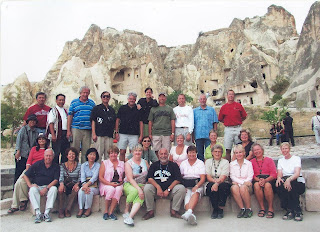
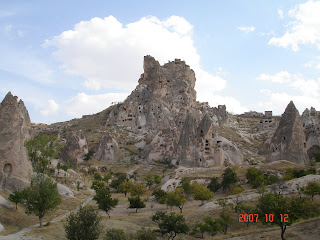


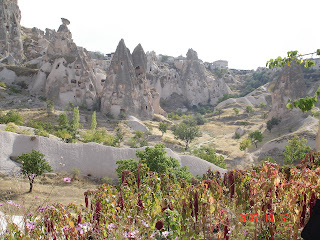


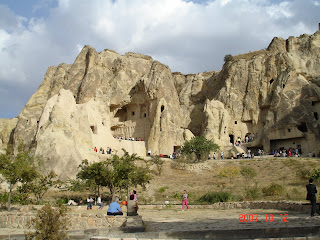

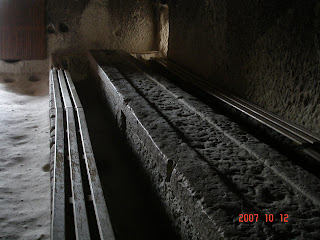


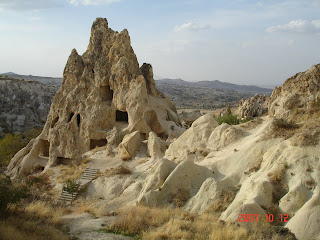


5:00 p.m. – After the tour, we got to explore a half hour on our own. Most people showed up at the rendezvous point earlier. It was starting to cloud up and we felt a few drops of rain. It’s been a long day and we are ready to head back to the hotel. Most of the group is going the Whirling Dervish dance show at 9:45 pm. I’m taking a pass and going to bed early. We have our hot air balloon ride in the morning very early before pulling up stakes and moving on to Ankara 170 miles up the road toward Istanbul. We’ve been here a week but it feels a lot longer.
8:00 p.m. – Had dinner in the hotel and am going to bed.
Day 10 - Saturday, October 13, 2007 - Ankara, Turkey
Itinerary - Depart for the city of Ankara, home of the 12th century Aladdin Mosque. Upon arrival, visit the Mausoleum of Kemal Ataturk, first president and founder of the Turkish Republic. Leading up to the Mausoleum, also known as the Anitkabir, lies a vast brick courtyard and monumental avenue lined with NeoHittite stone statues and cenotaphs (monuments erected in honor of a person whose remains are located elsewhere) beneath its colonnades. The most noted cenotaphs within the complex are those of General Ismet Inonu, a close comrade of Ataturk's and his successor, and that of Ataturk himself, a large and highly decorative marble cenotaph, beneath which lies his tomb.
Diary:
4:30 a.m. – Got up early. We’re going for a hot air balloon ride in a few hours. The Kapadokya Balloon Company is coming at 5:15 am in a van to take us to their headquarters to pay our $200 fee and then out to a field in the Göreme Valley to meet our balloon. Most everyone in the group is going.
6:00 a.m. – We got in a van and drove to Göreme to the balloon company headquarters. They served us coffee and cookies while we were waiting to drive a few miles away to the launch field.
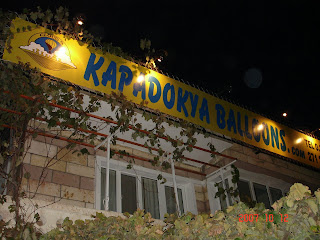

6:45 a.m. – We loaded 16 people into our van and drove to the area where they inflate the balloons. When we arrived, the balloon was still packed in a tight square. Workers unfurled the parachute and inflated them with a giant fan and then turned on the propane jets to heat up the air. The flames were 10 feet long. They connected the basket half way through and inflated it till the balloon rose high in the sky. We then climbed into the basket, which had four compartments holding four people each. We had a safety drill in case the winds were strong and we had a rough landing. Then the pilot gave a long blast of the propane jet and we lifted off and into the sky over the valley. Our balloon rubbed up against another one shortly after take off.
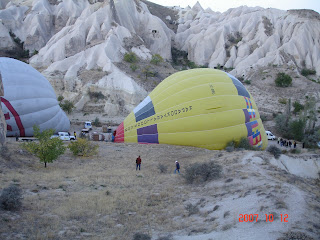


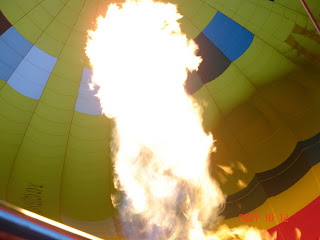
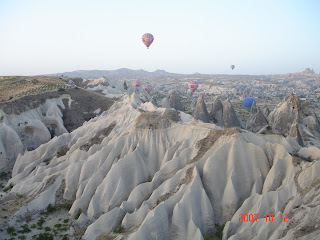
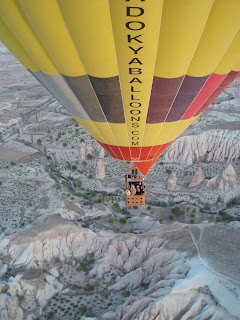 7:30 a.m. We’re up floating over the Göreme Valley. We’re pretty much seeing a lot of what we saw yesterday, but from a different perspective. It’s a perfect day, so the viewing is great. It’s much warmer than we thought it would be. It’s perfectly quiet since we are traveling at the same speed as the wind. We will be landing several miles away in a field. There are chase vehicles tracking us so they can pick us up when we land. The pilot’s name is Sirhan. He knows our tour director Salih and was once the ground manager for Gate1 in Cappadocia. He speaks perfect English, having gone to college in Washington DC several years ago. The pilot can only control the height of the balloon and turn the basket around on its axis so everyone gets a good view. We came down very low to the ground just over the treetops and soared just over the mountain peaks. Pretty cool. We counted 22 other balloons in the sky. Got some good photos.
7:30 a.m. We’re up floating over the Göreme Valley. We’re pretty much seeing a lot of what we saw yesterday, but from a different perspective. It’s a perfect day, so the viewing is great. It’s much warmer than we thought it would be. It’s perfectly quiet since we are traveling at the same speed as the wind. We will be landing several miles away in a field. There are chase vehicles tracking us so they can pick us up when we land. The pilot’s name is Sirhan. He knows our tour director Salih and was once the ground manager for Gate1 in Cappadocia. He speaks perfect English, having gone to college in Washington DC several years ago. The pilot can only control the height of the balloon and turn the basket around on its axis so everyone gets a good view. We came down very low to the ground just over the treetops and soared just over the mountain peaks. Pretty cool. We counted 22 other balloons in the sky. Got some good photos.




8:15 a.m. – Our balloon landed softly right on the trailer of the truck that takes it back to the starting point. No rough landing. The driver was told to take us right back to the hotel so we can have breakfast and leave for Ankara by 9 am. No champagne like the other groups. On the way out of the field, our van got stuck in the dirt right up to the axle so we had to get out and have a jeep pull it out of the dirt.

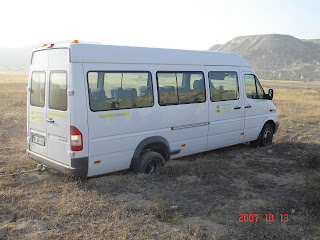
9:30 a.m. – We’re in the bus headed to Ankara. It’s 170 miles away. We have some stops to make and won’t get there till 4 pm. I bought a copy of the group photo taken yesterday at Cappadocia.
9:35 a.m. – Funerals in Turkey. People are buried within hours of death and funerals are free. They only do burials these days--no cremations. When someone dies, you call the city. They ask who, when and where. Who died, when the service is, and what mosque the funeral be held at. The person you call picks up the body and washes it. There is no embalming. They wrap the body in a shroud and put it in a simple coffin that is reused. The shroud has a saying on it that says “you cannot kill the dead.” If you die at 10 am, you’ll be in the ground by 12:30 pm. There is an announcement of the service at the mosque and the community is invited to come. The funeral occurs outside the mosque. Weddings and funerals are always held outside the mosque. Before burial, the priest asks if anyone has anything to say or forever hold your peace. So, if the deceased owes you money, you say so, so that the family knows. Typically, you carry the coffin to the cemetery. But if it’s a long way away, they drive the body and carry the coffin the last 100 yards. By the time you arrive, the hole is already dug. They just dump the shrouded body in the grave and bury it. The priest says a few words and then you go to the family’s house. 7 days and 40 days after the funeral, you go to the family’s house again to pray.
11:00 a.m. – Stopped at Turkey’s Great Salt Lake, which is larger than our Great Salt Lake. It’s all dried up so all you see is a vast sheet of salt for as far as the eye can see. The salt is in large crystal form.

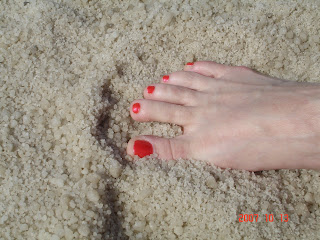
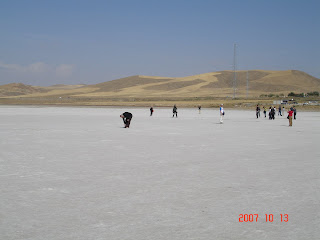
1:15 p.m. – Stopping for lunch. I walking around the stores. They have free wireless Internet but my laptop is locked on the bus.
2:00 p.m. – Back on the road again. The Internet works good. Weather in Ankara is 73ºF. It will be 57ºF in Istanbul for the next several days.
3:00 p.m. – We’ve arrived in Ankara, the capital of Turkey. 4 million people live here. It’s a sprawling, modern city. There are large murals of Ataturk on the sides of a whole bunch of buildings. He was the countries first President. We are going to visit his mausoleum.
3:15 p.m. – We’re at Ataturk’s mausoleum, as are several thousand other people. It’s a holiday so there are lots of visitors. Ataturk was born in 1881 in Greece. He went into the military and was famous for his victory at Gallipoli, where we were a few days ago when we crossed the Dardanelles Strait by ferry. After WWI, he started the war of Independence to get rid of the Sultan, whom nobody liked. In 1919, he declared the New Republic of Turkey. He brought in many reforms, such as introducing secularism. He also made people have a last name. His last name was Ataturk—Father of the Turks. He died at age 57 in 1938 from cirrhosis of the liver. Although he was married, he was a casanova and his wife eventually divorced him.



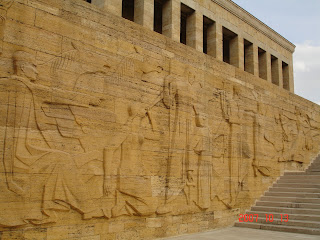


4:30 p.m. – We just finished Ataturk’s Mausoleum, which was built in 1953. It’s a massive sprawling complex on a hill in the center of Ankara. We toured the museum and adjacent buildings where his personal effects are on display. We skipped the line at the museum. There were two small kids staring at me—must be the blue eyes. I let them take a picture of Vicki, Vicky and I.
5:00 p.m. – At our hotel. It’s nice and in the center of nice. Good free Internet connection. We’re here for one night, and leave for Istanbul around noon.
9:00 p.m. – Well, it was an interesting evening. Dave and I went over to Wimpy’s Pub & Grill across from the hotel. Wicki, Wicky and Debbie came over later. We ate. I was the only one who liked the meal. Vicky and Debbie had spaghetti Bolognaise, but it was lacking sauce. Vicki had fish and chips, but the fish was like Mrs. Paul’s, and was old and stale. Vicky and Debbie left and went down to Burger King for some sodas, but came back a little later.
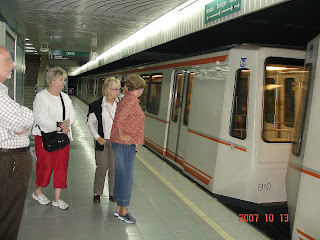 We then jumped on the Metro and went downtown three stops from the hotel. We got off in the center of downtown and it was really bustling. We walked around the shops on the main drag and in the pedestrian mall.
We then jumped on the Metro and went downtown three stops from the hotel. We got off in the center of downtown and it was really bustling. We walked around the shops on the main drag and in the pedestrian mall.  Vicky saw a club she wanted to go into. It was very loud, even from the street. So she and Vicki marched in there while Dave, Debbie and I stayed outside.
Vicky saw a club she wanted to go into. It was very loud, even from the street. So she and Vicki marched in there while Dave, Debbie and I stayed outside. 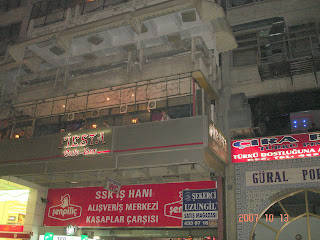
A few minutes later, they appeared on the balcony on the second floor. Then they disappeared. I told Debbie we should wait a minute or two because they would be down any minute. Sure enough, they came back. We went to the Metro and came back to the hotel. Dave and I stopped at Wimpy’s for a beer. Turkey was playing Moldova in soccer. We came home though after one beer. Tomorrow is another long day.
Day 11 - Sunday, October 14, 2007 - Ankara & Istanbul, Turkey
Itinerary - Visit the Anatolian Civilizations Museum in Ankara in the morning. The museum is housed in two Ottoman buildings located near Ankara Castle. The Museum, being among exceptional museums with its unique collection, has Anatolian archaeological artifacts, artifacts from the Palaeolithic Age to the present are exhibited. Depart for your hotel in Istanbul.
About Anatolian Civilizations Museum: The Anatolian Civilizations Museum is one of the most important museums in Turkey. It is made up of two buildings, Caravansary and Bedesten which were built around 1464 - 1471. Its valuable collection encompasses the story of all the various civilizations established in Asia Minor. This museum houses artifacts from the Hittites, Urartians, Assyrian Colonies, Phrygians, Greeks and Romans.The exhibits are displayed chronologically beginning with a collection of stone utensils for daily use dating from the Paleolithic period and semi-precious jewels from the 6th millennium.
Diary:
8:15 a.m. – Nice day. A lot cooler but sunny. We will have a high of 57ºF today. Dave and I are going on the optional Anatolian Civilizations Museum. The girls are sleeping in. Ankara is in the Anatolia region of Turkey. About 10 of us from the group are going. They will meet us at the museum at 10:15 am and then we will head to Istanbul, which is several hours away.
The Anatolian Museum was voted best in the world in 1997. It is inside a 10-domed, 15th century building that once was the central market building. The museum contains bas reliefs and statues while the surrounding hall displays exhibits from earlier Anatolian civilization.
8:30 a.m. – On way to museum. We passed a station with a bunch of vans that serve as taxis called domuses, which means “shared taxi.” You just flag it down when you need one and it takes you where you need to go for just pennies. They used to use old 1950s automobiles, but not anymore.
10:00 a.m. – Done with the museum. It was very interesting. We viewed the Hittite section first containing statues of lions and kings. I liked the section with all the items found in King Midas’ tomb. It was like King Tut’s tomb at the Egyptian Museum in Cairo. It’s amazing how advance civilization was even 3,000 years ago.








10:15 a.m. – The bus is here with the rest of the group. So we’re off to Istanbul.
12:00 p.m. – Had a bathroom break. It’s raining. Hopefully when we get over the mountains, it will stop. The rest stop had wireless Internet so was able to check mail.
12:30 p.m. – We slowed down for a car accident. Gruesome. Salih told us the ambulances and police cars were coming up on the left side and to look away if we didn’t like to see this stuff. We drove past slowly. There was a banged up black station wagon facing the opposite direction. There was an unconscious or dead woman in a black burka slumped over but strapped into the front passenger seat. I saw her face. The police were trying to pry open the passenger side door.
3::30 p.m. – Stopped for lunch an hour ago. Got some free entertainment. The place is really packed. I skipped lunch and went over to the shop that sells cheese, meats and candy. Several of us bought the candy-coated nuts. Mmmmm. When I came back, our program director was having a loud discussion with some crazed guy by the cashier at the end of the cafeteria line. I don’t know what happened, but it got a bit heated. Then Salih walked to the door and signaled the guy to put his food down and come outside. The crazed guy continued to make a stink. He walked by with his tray and family and sat down at a table. Salih was still outside, but now about 20 security guards has gathered around the crazed guy’s table and there was some commotion going on I couldn’t see. Eventually things calmed down and things returned to normal. Debbie and Vicky went to the lady’s room but they had only one Western-style toilet so it took them 15 minutes to pee. When Salih got back on the bus, there was a polite smattering of applause. Salih said the crazed guy asked him who the hell he thought he was standing at the head of the line getting in his way. Salih tried to ignore him, but the discussion escalated. The guy called Salih some names. A woman in line behind the crazy guy told Salih to leave her brother alone because he was “sick.” Since it is taboo for men to argue in front of women and the place was full of families coming back from holiday, he asked the man to come outside. The man called Salih some more really bad names and Salih said he told the guy if he didn’t shut up, he would kill him. That’s when the restaurant realized things might get out of control and sent the security guards out to subdue the crazed guy. The owner even came out with his gun, though I didn’t see it.
 Salih said that we will have covered 2,200 miles on the road by the time this trip is over.
Salih said that we will have covered 2,200 miles on the road by the time this trip is over. 5:00 p.m. – We are moving really slowly. The holiday traffic is coming home to a city of 15 million. We are still 80 miles away and just crawling along. At this rate, we won’t be in Istanbul until 8 pm. We were planning to go over to the Taxsim district in Istanbul where all the action is, but may have to wait one more night to do this.
5:15 p.m. - They put this Eddie Murphy movie on the bus’s DVD player called Norbert a little while ago. It just cut out for no reason. When it did, someone yelled “Halleluiah!”
5:45 p.m. – Just stopped for a bathroom break. We were informed the traffic is really bad. There are only two bridges leading into Istanbul and they are really backed up due to the rain and holiday traffic. It would be several hours before we get to the hotel even though we are close to Istanbul.
6:30 p.m. – We are in Istanbul, but far from the hotel.
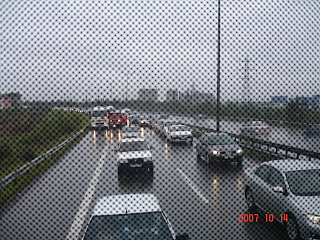 7:30 p.m. – Still stuck in traffic. We’ve seen this guy walking along the expressway for about 15 minutes now. He has passed us four times already. That’s how slow we are creeping along. We are planning our next trip: 1. Costa Rica/Cuba in January, 2. Poland, 3. Chile/Argentina, 4. Russia, 5. Kenya safari, 6. China (Chris only).
7:30 p.m. – Still stuck in traffic. We’ve seen this guy walking along the expressway for about 15 minutes now. He has passed us four times already. That’s how slow we are creeping along. We are planning our next trip: 1. Costa Rica/Cuba in January, 2. Poland, 3. Chile/Argentina, 4. Russia, 5. Kenya safari, 6. China (Chris only).8:00 p.m. - Still stuck in traffic. Packer game is starting.
 8:30 p.m. – We are finally here. 10 hours and 15 minutes on the road. Dave and I are going to the Wood Shield, a British pub 2 blocks away, for dinner.
8:30 p.m. – We are finally here. 10 hours and 15 minutes on the road. Dave and I are going to the Wood Shield, a British pub 2 blocks away, for dinner. 10:00 p.m. - Dinner was great. Vicki, Vicky and Debbie just walked in the bar. How did they find us? Anyway, it’s nice to have them here. The lights went off and they brought out candles. The electricity goes off all the time, so they were well prepared.
11:00 p.m. – We’re back at the hotel. Time for bed. Lots of sightseeing tomorrow. Zzzzz.
Day 12 - Monday, October 15, 2007 - Istanbul, Turkey
Itinerary - Half Day Istanbul with Topkapi Palace (AM), including Hippodrome and Blue Mosque. In the afternoon, enjoy a half day Istanbul Bosphorus River Cruise.
About Topkapi Palace: Following the conquest of Istanbul, between 1459 and 1465, Mehmet II built the Topkapi Palace as his principal residence and seat of government. The site is like a separate town with its own fortifications. Inside, among courtyards, gardens, pools and fountains there are both public and private buildings, chambers, kiosks and pavilions. Some of the collections housed at the museum include Ceramics, Glass, Silverware, Imperial Costumes, Arms and Armor, Miniatures and Manuscripts and Clocks. The famous Treasury contains one of the the richest collections of treasures in the world. Many gold and silver objects are displayed, most are embellished with precious stones. Don't miss the 86-carat spoonmakers diamond and the Kanjar, 14 inch emerald encrusted dagger.The Famous movie Topkapi starring Melina Mercouri and Peter Ustinov was filmed in here in 1964.
About Blue Mosque: Blue Mosque, Sultan Ahmet Camii is one of the most beautiful mosques in the world. Its name is derived from the blue tiles decorating its interior. Completed in 1616 by Mehmet Aga, Imperial Architect and one of the students of the great architect Sinan. Its grace and beautiful proportions were intended to reflect the splendour of Islam. It was the supreme Imperial Mosque of the Ottoman Empire. The famous blue and green Iznik tiles on the walls are bathed in glorious light that is filtered through 260 windows. On summer evenings there are light and sound shows in the grounds.
Diary:
8:45 a.m. – Dave, Wicki, Wicky, Debbie and I are taking the optional tour to Hippodrome, Blue Mosque, Topkapi Palace. The girl will then go to the Grand Bazaar to shop while Dave and I go on the Bosphorus River Cruise.
9:00 a.m. - At the Hippodrome, which means horse track. The Hippodrome was used for chariot racing and held 100,000 people. Out in front are three pillars.
 The first is a tall stone column that used to be copper-plated, but the copper was removed when the metal was needed.
The first is a tall stone column that used to be copper-plated, but the copper was removed when the metal was needed. 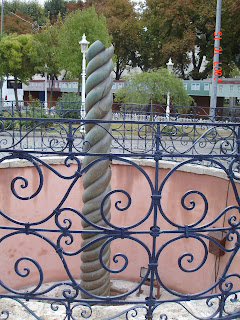 Next was the Serpent Column, which was three intertwined snakes. The heads are missing though. The column was made in Delphi in 479 BC and move here later.
Next was the Serpent Column, which was three intertwined snakes. The heads are missing though. The column was made in Delphi in 479 BC and move here later.  The last column is an obelisk modeled after the obelisk at the Temple of Karnak in Luxor, Egypt. It has hieroglyphics up the side and was built 3,500 years ago. The hieroglyphics basically say what a good guy the emperor was. The original obelisk was 9 yards shorter. They had to cut the bottom off to fit it on a ship to come from Egypt. The bottom 9 yards were added later. There are “thumbs up” and “thumbs down” symbols on the obelisk. They mean the exact opposite of what they meant in the Roman Empire. “Thumbs down” meant “let him live.” “Thumbs up” meant “kill him.”
The last column is an obelisk modeled after the obelisk at the Temple of Karnak in Luxor, Egypt. It has hieroglyphics up the side and was built 3,500 years ago. The hieroglyphics basically say what a good guy the emperor was. The original obelisk was 9 yards shorter. They had to cut the bottom off to fit it on a ship to come from Egypt. The bottom 9 yards were added later. There are “thumbs up” and “thumbs down” symbols on the obelisk. They mean the exact opposite of what they meant in the Roman Empire. “Thumbs down” meant “let him live.” “Thumbs up” meant “kill him.”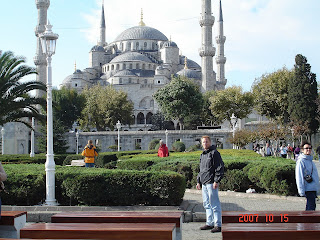 9:30 a.m. – We walked 100 yards over to the Blue Mosque. It is recognizable by its five domes and 6 minarets. It is only called this in the tourist books because blue was the predominant color after the original construction. The mosque is known to locals as the Mosque of Sultan Achmed, who built it out of jealousy over the Aye Sophia church close by. The original mosque had blue silk carpeting and blue tiles and mostly blue stain glass windows. It was built from 1609-1616. The original blue paint had faded over the years, but one column has a section restored to the original blue color to give you an idea of what it looked like when it was new.
9:30 a.m. – We walked 100 yards over to the Blue Mosque. It is recognizable by its five domes and 6 minarets. It is only called this in the tourist books because blue was the predominant color after the original construction. The mosque is known to locals as the Mosque of Sultan Achmed, who built it out of jealousy over the Aye Sophia church close by. The original mosque had blue silk carpeting and blue tiles and mostly blue stain glass windows. It was built from 1609-1616. The original blue paint had faded over the years, but one column has a section restored to the original blue color to give you an idea of what it looked like when it was new. The silk blue carpet is gone. They had most of the floor space blocked off to tourists so the mosque would be easier to clean. When people come to pray, they touch their head to the floor, so it makes sense to try to keep the floor clean by keeping tourists off of it. Before you enter, you have to take your shoes off and put them in a plastic bag and carry them with you.

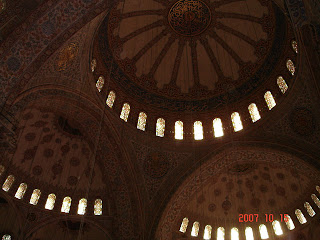
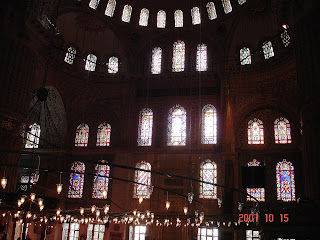
The Aye Sophia (means Holy Wisdom) is still more grand than the Blue Mosque. The dome on the Aye Sophia is 10 yards wider, 10 yards higher and 1,100 years older and completed in only 5 years vs. 6 for the Blue Mosque. The problem is that the Aye Sophia builders did not dig down to the bedrock when building it. The Aye Sophia rests half on bedrock and half on unstable ground. The Blue Mosque, however, is built on solid bedrock. They dug 80 yards deep to make sure it rested on one piece of rock so that if an earthquake struck, the entire mosque would roll as a unit. Aye Sophia could break up if a major earthquake struck. There is one huge dome in the center of the Blue Mosque. To support the structure, there are a series of half domes surrounding it.
 The Blue Mosque once had candles in the gigantic circular chandelier that hangs over the main floor area. The mosque was designed with air inlets that would suck all the candle smoke to one side so that only one wall would be blackened by the smoke.
The Blue Mosque once had candles in the gigantic circular chandelier that hangs over the main floor area. The mosque was designed with air inlets that would suck all the candle smoke to one side so that only one wall would be blackened by the smoke. There are no spiders in the mosque because they hung fresh ostrich eggs around the church. The eggs give off a scent that humans can’t smell, but spiders hate.
The mosque was built by Ottoman soldiers.
Although the Sultan, who was the supreme ruler at the time, was consider equal to all other men in the eyes of God, he had to have a special area separate from the rest of the congregation for prayer because they were afraid he might be assassinated by someone. This happened to several previous Sultans before him. Women also have a special prayer area in the back and on the sides of the mosque because they don’t want men to be distracted by a women praying in front of them. Smart move. Don’t want any dirty minds at the mosque.
Muslims come to the mosque to pray, but you don’t have to do it in a mosque. When the time comes, you just have to know where southeast is in Turkey (direction of Mecca) and you can pray anywhere. When you pray, you have to recite this 99-sentence litany that begins with “God is great.” “God is merciless.” “God is …, God is ….” You keep track of your “God is” by using a special rosary called an abacus. If you don’t have one, you count using your knuckles. So the next time you see some Muslim guy talking to himself and making odd motions with his hands, you’ll know he’s not crazy but trying to keep track of the 99 “God is” phrases that they are required to recite as part of their prayers.
We noticed that a cleaning man at the mosque was using a Kirby vacuum cleaner. It was rather small considering the size of the floor used for prayer several times each day.
 10:20 a.m. – We walked from Blue Mosque to Topkapi Palace next door. This is a gigantic fortress high on a hill top surrounded by a wall overlooking the Bosphorus River below. The palace has four huge gardens and a number of buildings where the Sultan, his family, soldiers and concubines lived.
10:20 a.m. – We walked from Blue Mosque to Topkapi Palace next door. This is a gigantic fortress high on a hill top surrounded by a wall overlooking the Bosphorus River below. The palace has four huge gardens and a number of buildings where the Sultan, his family, soldiers and concubines lived.Salih is leading us on a tour of the palace. Our first stop right after entering the main gate was St. Irene’s church. The Sultan built it because his mother was Christian, not Muslim, and he was afraid to let her outside the walls of the palace, so gave her a place to worship. This is the only Christian church to remain standing after the Muslim takeover. Aye Sophia, which was originally a Christian church, was also spared because it was converted into a mosque. St. Irene’s church was built from 1460-65.

We then passed through the castle area gate. Only the Sultan was allowed to ride a horse through it. Before passing through the gate, we saw the execution area where there was a fountain for the executioner to wash his hands.
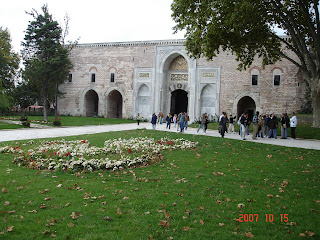
After passing through the gate, there was a large map on the wall showing the history of the Ottoman Empire, which stretched back hundreds of years (1299-1923) and, at its largest, encompassed an area stretching from Turkey to Italy, down to Egypt, across the entire Middle East and into parts of Russia. It eventually shrunk back to what is now Turkey, which still includes what was part of Iraq. Now you know why there is so much tension between Iraq and Turkey.

11:00 a.m. – We stopped at the palace kitchen. It employed 900 people who cooked for 3,000-4,000 soldiers, 1,000 concubines, and 1,000 others. The kitchen displayed some of their wares and the 3rd largest collection of Chinese porcelain in the world. Turkey is on the Silk Road between China and Europe. To make sure the Sultan wasn’t being poisoned, they used celadon. They believed that if the celadon changed color, the food was poisoned. We learned that the women in the harem would poison each others’ babies so that their sons might someday grow up to be the Sultan and then she would be the Queen Mother.


We then visited the Imperial Council Hall where the Sultan’s ministers met. There’s a large curtain inside. The Sultan would sometimes stand behind it to listen to what was being said. The ministers then had to be careful what they said because they never knew if the Sultan was listening. There were guns, swords and armor on display there.

We then passed through the Gate of Felicity and visited the Sultan’s audience hall.

When ambassadors came to visit from foreign countries, it meant something serious was brewing. To soften up the visitors, they would take them over to the Turkish bath and give them a nice meal. Then the visitor donned a heavy caftan, because European clothes were not permitted in the Palace, and the negotiations would start. But by then, the Sultan’s hospitality had softened the ambassador’s will and negotiations were not as tough.

12:00 p.m. – Salih has let us go on our own. We’re touring the treasury. Lots of gems, jewelry and assorted items. John the Baptist’s finger bones and piece of skull werethey not on display. They were found under the altar of a church in a jeweled box, probably because the crusaders had overlooked them when they ransacked the church. We did see the Topkapi Dagger, which was the subject of a thriller movie starring Peter Ustinov and Maximilian Schell.

12:15 p.m. – Dave and I went to the café for lunch. It’s located on the palace grounds overlooking the Bosphorus River. Great views. Lots of boat traffic on the river.
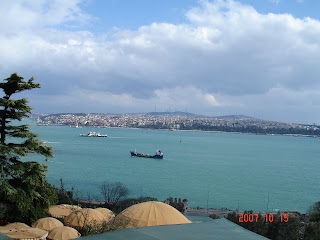
12:50 p.m. – We went back to the Treasury to see a room we missed because the lines were so long. The most important item was the Sultan’s chair, which was encrusted with precious gems and stones. We ran into Vicki, Vicky and Debbie. They then took off to go to the Grand Bazaar. Dave and I stayed at the Palace to tour the Sultan’s library.
1:00 p.m. – Visiting the gallery containing portraits of the 36 Sultans who ruled from 1299-1923. Salih was right, one of the Sultans looked just like him.
2:00 p.m. – We visited the Harem room for $8. It was worth it. We saw the place where the harem girls lived, bathed and entertained. The Queen of the Harem’s bathroom was interesting with it’s locked bath chamber. She never knew when she might be killed, so always locked the door behind her. The Sultan had a similar set up. Never can trust anyone.




2:19 p.m. – We’re getting back on the bus, but we’re four minutes late. Everyone was waiting for us. Nobody was at the meeting point when we got there, so we ran down the hill where we were told the bus would be waiting.
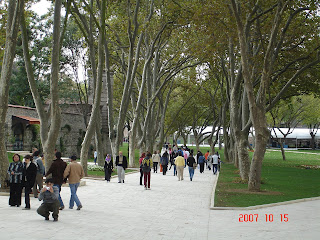
4:30 p.m. – We went on the optional Bosphorus River Cruise. The river is the main one going through Istanbul. It averages 180 feet in depth and is just bustling with other activities. We got nice panoramic views of the city and saw several important landmarks along the way.







We also saw where all the rich people lived along the river and passed beneath a few suspension bridges. It was pretty windy and cold, so some people sat below deck where it was toasty warm. The European continent was on the north side of the river and the Asian continent was on the south side of the river. There were a lot of other river cruise boats out on the river and seemed like we were jockeying to see which one could cut off the other’s chances of taking good photos. At times other boats would race up along side and get between us and something we were trying to take a picture of, and then we would return the favor at the next site.
 5:00 p.m. – Dave and I stopped at the Wood Shield for a beer. The girls are still shopping.
5:00 p.m. – Dave and I stopped at the Wood Shield for a beer. The girls are still shopping. 7:30 p.m. – I’ve been typing my journal for an hour. The girls are back from the Bazaar. We are going to the Taxsim area for dinner.
8:30 p.m. – We piled 5 people into a tiny cab and headed 10 minutes across the river to Taxsim square. I have never seen so many people in all my life. The main drag is a pedestrian mall line for a mile or so with a million shops, restaurants, bars and night clubs.



10:30 p.m. - We’re back from a night on the town. We had drinks and appetizers at this so-so place where the service was bad, probably because we sat on the second level to avoid the smoke and the waitress had to keep running up and down stairs. We had been sitting downstairs but the seating was cramped. When Vicky got up, the keyboard piano she was sitting next to fell off its pedestal onto the floor. The restaurant staff and Dave managed to pick up the keyboard and put it back on its legs. Apparently this has happened before. When we got to the second floor, some guy talking on his cell phone shushed us for being too loud. Vicky made friends and had her picture taken with the two Turkish men at the next table. By then we had paid our bill and split. We walked down the street and did some shopping. Vicky was buying evil eye souvenirs and dropped and broke one on the floor.


The store clerks clapped and then Vicky bargained her way down to $5 for two pieces. We stopped at another store that had loud Turkish music playing. The two boys running the store started dancing for Vicky. Then Vicky showed them a move or two and taught them how to dance her way. Oh, God. After 10 pm, all the shops closed and cabs got scarce, so we walked all the way down the shopping street to the streetcar station at Tunel and piled the five of us into a cab and came back to the hotel.
11:35 p.m. – Getting tired of typing. Time for bed. Another busy final day in Istanbul tomorrow.
Day 13 - Tuesday, October 16, 2007 - Istanbul, Turkey
Itinerary - Morning at leisure to explore Istanbul on your own. In the afternoon, enjoy the optional half day Istanbul with Grand Bazaars in morning, including Aya Sofia, Spice Market and Grand Bazaar. In the evening, enjoy a farewell dinner with local Turkish specialties and a glass of wine or raka.
About The Grand Bazaar: Istanbul's Grand Bazaar (Kapali Çarsi, or Covered Market) is Turkey's largest covered market offering excellent shopping: beautiful Turkish carpets, glazed tiles and pottery, copper and brassware, apparel made of leather, cotton and wool, meerschaum pipes, alabaster bookends and ashtrays, and all sorts of other things. Most guidebooks claim that it has 4000 shops. Because of consolidation and replacement of shops by restaurants and other services the number is certainly lower, but you get the idea: it has lots of shops. Not all of them, by the way, are for tourists; locals shop here as well, lending a welcome dose of authenticity. A dozen restaurants in the bazaar allow you to have lunch in the midst of your shopping. You'll want to hone your bargaining skills before you plunge into the markets.
About Aye Sophia: Haghia Sophia Museum, the great masterpiece of Byzantine art. It was built by Justinian in 6th century AD and is the 3rd church to occupy this site. At the time it was built, it was the largest church in existence. The church was sacked by the Latins during the 4th crusade in 1204 and many of its treasures taken to the west. When Contantinople (Istanbul) was conquered by the Ottoman Sultan, Mehmet II in 1453,it was converted into a mosque. Since 1936, by Ataturk's order it has been a museum. The interior is decorated with wonderful Byzantine mosaics from 6th to 13th century AD.
Diary:
4:30 a.m. – I’m up early. Did not sleep well at all. I am busy editing photos that I copied onto my laptop from Dave's and Vicky’s cameras. There are a lot of duplicates to delete.
8:00 a.m. – It’s another cool but sunny day today. It’s going to be 57ºF again. Sweatshirt weather all the way. We have the morning free. I knocked on Vicki, Vicky and Debbie’s door but got no response. Must be sleeping. They’re going shopping. Dave and I are also free all morning so we’re going to sightsee on our own and join the optional tour to the Spice Market, Aye Sophia Church and the Grand Bazaar at 12:15 pm. We’re actually going to the Spice Market and Grand Bazaar, so will blow off that part of the tour.
 8:30 a.m. – We’ve walked a few blocks from the hotel over to Sirkeci Station. This was the last stop on the Simplon-Orient Express—king of trains and train of the king—between Paris and Constantinople (Istanbul) from 1883-1977.
8:30 a.m. – We’ve walked a few blocks from the hotel over to Sirkeci Station. This was the last stop on the Simplon-Orient Express—king of trains and train of the king—between Paris and Constantinople (Istanbul) from 1883-1977. 12:00 p.m. – Dave and I cruised through the Spice Market and Grand Bazaar for 3 hours. We’re going to these places on the tour this afternoon, but couldn’t wait until then to shop for gift. Of course, I bought nothing, but Dave bought a bunch of stuff for the folks back home. We’re hoping the tour starts at Aye Sophia so we don’t have to see these sites again. The Spice Market is quite small.


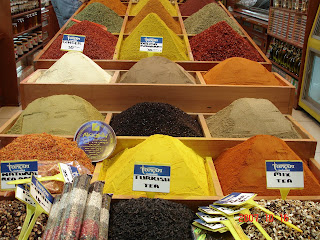



We were done in 15 minutes. The Grand Bazaar is a whole different story. It’s basically a whole lot of downtown streets covered by a roof. It’s utterly huge with virtually everything and anything for sale.



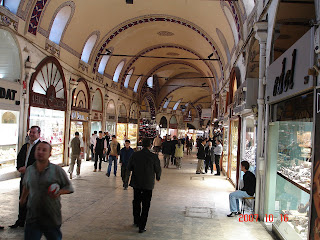
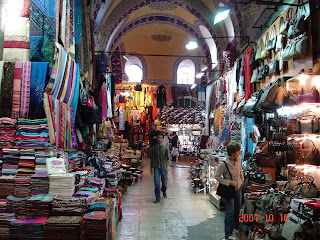
We're at the Wood Shield having lunch before we have to run a few blocks over to the hotel to catch the bus.
12:15 p.m. – We’re on the Gate 1 B bus. We were on the A bus with our program director Salih. About 6 people from the A bus joined maybe 7 people from the B bus for the tour.
12:20 p.m. – We’re at the Spice Market again. The B bus guide never told us his name even though we’ve seen him on an off over the duration of the tour. The Spice Market was built in the 1660 by the mother of the Sultan. The Turkish actually call it the Egyptian Market because, when it was built, all the spices came from Egypt. The market traditionally has sold spices, tea, and Turkish delight, which looks like an assortment of dried fruits with powder sugar coating. We’ve seen it everywhere. The locals shop at the Spice Market. You don’t bargain for price here like you do at the Grand Bazaar. You can bring spices back to the US as long as they are vacuum sealed. Same goes for dried fruit.
1:15 p.m. – We’re on our way to Aye Sophia. Rather than shop at the Spice Market, I walked across the square to the Yeni Mosque.

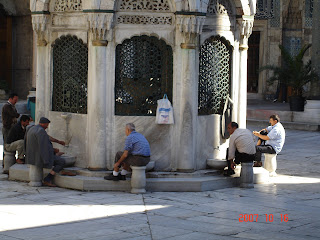

Despite being 400 years old, it is still referred to as the new mosque. The place is infested with pigeons and there are ladies sitting at booths selling plates of seed to feed them. I wandered inside where men and women were sitting at the fountain washing their feet so they could pray in the mosque. The mosque is very ornate and domed like the Blue Mosque. The call to prayer rung out loud and clear over loud speakers at 1 pm. Very eerie.
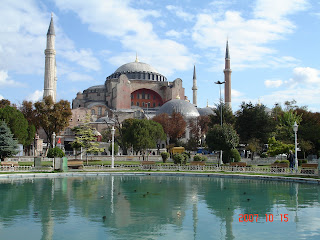 1:15 p.m. – We’re at Aye Sophia. It is the third church to be built on this site after the others were burned and the 4th largest church in the world next to St. Paul’s in London, St. Peter’s at the Vatican and the Duomo in Milan, Italy. It was built from 532-537 AD. It took 2,000 experts and 10,000 workers to plan and build it. Two Byzantine architects designed it. All Christian nations provided money, workers and materials to help build it, which explains why it only took 5 years to build. The church was commissioned by the Eastern Roman (Byzantine) emperor Justinian who claimed that the church’s design was communicated to him by the Archangel Gabriel. Hence, building the church was the realization of a dream.
1:15 p.m. – We’re at Aye Sophia. It is the third church to be built on this site after the others were burned and the 4th largest church in the world next to St. Paul’s in London, St. Peter’s at the Vatican and the Duomo in Milan, Italy. It was built from 532-537 AD. It took 2,000 experts and 10,000 workers to plan and build it. Two Byzantine architects designed it. All Christian nations provided money, workers and materials to help build it, which explains why it only took 5 years to build. The church was commissioned by the Eastern Roman (Byzantine) emperor Justinian who claimed that the church’s design was communicated to him by the Archangel Gabriel. Hence, building the church was the realization of a dream. It was the center of Christianity in 1054, and later the center of the Greek Orthodox church when the church split into two parts—Greek and Roman. After Istanbul was conquered in 1453, it was converted into a mosque by Mohammed II, one of the 36 Ottoman Sultans. It was a mosque until 1924 when Ataturk led Turkey into its independence and became the country it is today. Ataturk turned it into a museum.


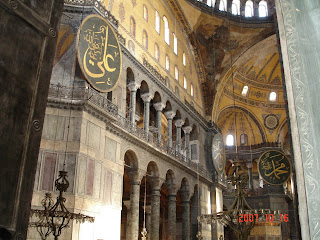








Yesterday, Salih told us that Aye Sophia means Holy Wisdom in Greek. This church is more grand than the Blue Mosque. The dome on the Aye Sophia is 10 yards wider, 10 yards higher and 1,100 years older and completed in only 5 years vs. 6 for the Blue Mosque. The problem is that the Aye Sophia builders did not dig down to the bedrock when building it. The Aye Sophia rests half on bedrock and half on unstable ground. The Blue Mosque, however, is built on solid bedrock. They dug 80 yards deep to make sure it rested on one piece of rock so that if an earthquake struck, the entire mosque would roll as a unit. Aye Sophia could break up it a major earthquake struck.
The entrance way had a mural of Christ. The exit facing it had a mirror on it so the congregation could see the mural on the way out and be reminded to be good Christians.
2:15 p.m. - The Aye Sophia was massive. Unfortunately, the dome was being restored. Scaffolding extended from the floor to the apex of the dome. Very beautiful inside. Tour Director B gave us some free time, so we went up to the mosaic gallery to see a number of gold mosaics. My guide book said not to miss it, but Tour Director B never said anything about it. We also went and stuck our thumbs in the Weeping Pillar. Legend has it that the pillar is that of St. Gregory the Miracle Worker. If you put your finger in this hole in the pillar and it comes out moist, your wishes will come true.
3:00 p.m. – Dave and I ditched the group rather than go back to the Grand Bazaar. We’re back at the Wood Shield having a beer.
5:00 p.m. – Busy typing this journal and preparing my tip envelopes for Salih, Sadet (bus driver) and Irfan (bus driver’s assistant). Gate1 recommended a tip of $6-$7 per day per person for Salih and $3 per day per person for the driver. It didn’t say what to tip the assistant, but $1 per day per person is customary. Salih was the best tour guide I ever had. I learned a lot about Turkey—people, culture and history. I’m giving him $100 for the 12 days. I’m giving $40 to the driver and $15 to the assistant. Tips are a big deal on these tours. I’m sure Salih will net close to $3,000 from our group of 31.
10:00 p.m. – We’ve had our farewell dinner at a local restaurant.

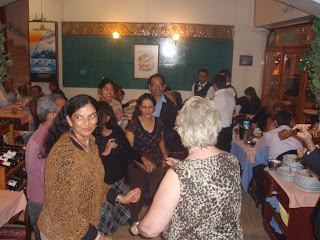

It was nice. Even had live music and a little dancing among the group--Vicky included. The group we traveled with was wonderful. It’s sad to see everyone go home. We exchanged e-mail and home addresses so we can stay in touch. Some people have to go to the airport at 2:00 am. Debbie leaves at 3 am. Vicki and Vicky leave at 6 am. Dave and I are the last to leave at 11:45 am. Everyone else is getting home tomorrow. Dave and I get into New York so late that we can’t get flights to Milwaukee or St. Louis until Thursday morning. That’s OK though, I’m not quite ready to go back to work yet.
10:30 p.m. - Down in Vicki, Vicky and Debbie's room.


They're trying to pack their bags for the trip home tomorrow. They shopped as much today as yesterday. The room looks like a tornado hit it. They have so much stuff I don't know how they're going to fit it all in their suitcases. But they always manage somehow.
11:00 p.m. - Time for bed. Long travel day tomorrow.
Day 14 - Wednesday, October 17, 2007 - Travel from Turkey to USA
Itinerary - Day of leisure before transfer to airport in the afternoon for your departure flight back to the USA.
Diary:
6:00 a.m. - Didn't sleep well again. But we have to go home today so I'll be able to sleep on the plane. Some of the group had a 2:45 am departure for the Istanbul Airport, including Debbie and the Green Bay group. Vicki and Vicky are leaving now. There are a few more at 9 am. Dave and I are the last to leave at 11:45 am. We have to stay in New York since we get in late from Amsterdam. I'll get home tomorrow.
8:00 a.m. - Another nice fall day here. Sunny and cool. Nice day to travel home. We really lucked out on the weather this entire trip. All in all the hotels were pretty decent as well, but charging $50 for a cheap bottle of wine, $12 for Jack Daniels on the rocks and $8 for a beer got to be a bit much. So we often ventured out a lot to the bars and restaurants when we were on our own for dinner. The food was pretty good throughout the country but the portions were much smaller than we're accustomed to in the US. I didn't run at all while I was here, but didn't gain much weight. My feet are feeling better too so I'll be ready to start running again when I get home. The tour group we traveled with was great. There were no head cases in the group. And we got the better of the two program directors. Salih made the trip very interesting. I told him that I learned a lot about the country, its history, its people and culture. So when someone asks "Why Turkey?" I can say "Why Not?" Turkey truly is "The Crossroads of Civilization." The country is so rich is history and culture. It was well worth the visit. We never had a dull moment and the more we ventured, the more we learned to love it.
10:45 a.m. - The nice part about leaving later is that we had time to do some last minute shopping at the Grand Bazaar. I spent $20 on some hand painted bowls and a brass lamp. I'll bring the lamp to meetings when things aren't going well and see if I can conjure up a genie to grant our wishes. I also raided the linen room on my floor and helped myself to one of the bathmats from our hotel. They are white and have the outline of feet on them. All in all, there weren't as many shopping bargains as I expected. I was hoping to get some good buys before Turkey joined the European Union. Unfortunately, the prices were very high relative to Asia. And no matter how well you think you bargained, the merchants probably always quadrupled their money. The carpet store guys are the worst bunch. They try to make friends with you to get you into their shop. It's really annoying but part of the game. Yesterday, one of them said, "Come into my store. We don't cheat customers as much as the others." Anyway, we leave for the airport in an hour.
11:45 a.m. - Our driver is here and Dave and I are off to the airport. The last ones.
1:30 p.m. - Well, we got to the airport and were checking in when KLM told us the flight was full and offered us $100 to fly Air France to New York arriving at about the same time. We took the offer and will fly to New York via Paris. While we were standing in line, 3 people from the B Bus showed up. I don't feel so bad because they have to stay in New York overnight as well. Included in the threesome was the blond haired girl from Austin.
2:00 p.m. - We're through security and sitting in the lounge having a beer. I spent my last 20 Turkish liras. $8 per beer. Getting screwed right to the end. We stopped at the duty free "Old Bazaar" but they didn't have the same crap as the Grand Bazaar. Where were the hand painted ceramic bowls, the brass genie lamps, the carpet stores? They did have a Turkish Bath kit, but you have to provide the masseuse.
4:00 p.m. - We're off to Paris. Good bye Turkey.
6:20 p.m. - Paris Time (One hour behind Istanbul)- Our flight arrived a little ahead of schedule. It took about 3 hours. Since our flight leaves in only 30 minutes, a van picked us up and shuttled us over to the terminal. I don't think our luggage is going to make it.
6:55 p.m. - Paris Time - We're off to New York City.
8:55 p.m. - New York Time (six hours behind Paris) - We've arrived in New York. The flight took 7 hours 5 minutes. I slept most of the way. The video screen at my seat had a broken brightness switch so the picture was too dark to watch any movies or TV. It didn't really matter. All the selections were pretty poor.
 9:05 p.m. - New York Time - We cleared customs fast. At the baggage claim, there was a message board telling all the Gate1 people to see the Air France agent at the gate. Sure enough, our luggage didn't make it. They will send it to my house tomorrow or Friday. There's nothing in there I need anyway. They gave us a toiletry bag with a Sky Team T-shirt.
9:05 p.m. - New York Time - We cleared customs fast. At the baggage claim, there was a message board telling all the Gate1 people to see the Air France agent at the gate. Sure enough, our luggage didn't make it. They will send it to my house tomorrow or Friday. There's nothing in there I need anyway. They gave us a toiletry bag with a Sky Team T-shirt.10:00 p.m. – Called Vicky to see if she and Vicki made it back to Little Rock. They made it safe and sound but almost missed their flight from London Heathrow to Chicago because they were screwed up on the time. They were what seemed to be a ½ mile from their gate when they realized their flight would be leaving in 10 minutes. They ran the whole way to the gate and made it, but BARELY!!! They were lucky to have an empty plane. Vicki had 3 seats to herself and Vicky had a row of 4 seats to herself. I love it like that because, with enough Valium, you can sleep across the seats all the way home and arrive rested and ready to go. I talked to Vicky #3 for a few minutes because Vicki and Vicky were busy sorting through all their purchases. I think the Turkish economy got a good lift from them and the rest of our group.
11:00 p.m. - We're at the hotel. It's in Queens about 10 minutes from LaGuardia. We have a 5 am wake up call. I'm going to try to get on the 7 am flight to Milwaukee. Dave's flight to St. Louis leaves at 8:30 am.
Day 15 - Thursday, October 18, 2007 - Travel from New York City to Milwaukee
Itinerary - Check out of your hotel in New York City and head to the airport for your trip home.
Diary:
5:00 a.m. US Eastern Time – At the Comfort Inn in Queens. It was quite comfortable but the Queens location in Chinatown was kind of dicey and the hotel was located in the basement of the building, which is a six story apartment complex. Our windows looked up to the sidewalk. There were only about 5 rooms in the entire hotel. I’m going to try for the 7 am flight to Milwaukee.
5:30 a.m. – We’re in the cab headed to LaGuardia.
7:30 a.m. – I managed to get on the earlier flight to Milwaukee. I should be home by 8 am Central Time. I called Brenda over at my condo to tell her to be on the lookout for my luggage today or tomorrow. Fortunately, I have everything I really need with me.
8:15 a.m. - US Central Time - Just landed in Milwaukee. Feels good to be home. My luggage should arrive in New York from Paris any minute now. I should have it later today or tomorrow.
9:00 a.m. - Back at the office. I have two weeks of email to plow through. Several people have stopped by to welcome me back. They read my daily postings from the road. They said it sounded very interesting, almost like they had been there themselves. They're no longer asking "Why Turkey?" They get it. Mission accomplished.
Chris
Friday, October 19, 2007 - Milwaukee
Diary:
 2:00 p.m. - My luggage caught up with me today. It was sitting in my condo when I got home from work. Three out of the 4 small ceramic bowls I bought at the Grand Bazaar in Istanbul were broken. But at least I have one. My genie lamp also survived, as did the bathmat from the Prince Hotel. Vacation is over and I'm back at work. Guess it's time to dream about my next vacation.
2:00 p.m. - My luggage caught up with me today. It was sitting in my condo when I got home from work. Three out of the 4 small ceramic bowls I bought at the Grand Bazaar in Istanbul were broken. But at least I have one. My genie lamp also survived, as did the bathmat from the Prince Hotel. Vacation is over and I'm back at work. Guess it's time to dream about my next vacation. APPENDIX
OFFICIAL NAME: Republic of Turkey
BACKGROUND: Modern Turkey was founded in 1923 from the Anatolian remnants of the defeated Ottoman Empire by national hero Mustafa KEMAL, who was later honored with the title Ataturk, or "Father of the Turks." Under his authoritarian leadership, the country adopted wide-ranging social, legal, and political reforms. After a period of one-party rule, an experiment with multi-party politics led to the 1950 election victory of the opposition Democratic Party and the peaceful transfer of power. Since then, Turkish political parties have multiplied, but democracy has been fractured by periods of instability and intermittent military coups (1960, 1971, 1980), which in each case eventually resulted in a return of political power to civilians. In 1997, the military again helped engineer the ouster - popularly dubbed a "post-modern coup" - of the then Islamic-oriented government. Turkey intervened militarily on Cyprus in 1974 to prevent a Greek takeover of the island and has since acted as patron state to the "Turkish Republic of Northern Cyprus," which only Turkey recognizes. A separatist insurgency begun in 1984 by the Kurdistan Workers' Party (PKK) - now known as the People's Congress of Kurdistan or Kongra-Gel (KGK) - has dominated the Turkish military's attention and claimed more than 30,000 lives. After the capture of the group's leader in 1999, the insurgents largely withdrew from Turkey, mainly to northern Iraq. In 2004, KGK announced an end to its ceasefire and attacks attributed to the KGK increased. Turkey joined the UN in 1945 and in 1952 it became a member of NATO. In 1964, Turkey became an associate member of the European Community; over the past decade, it has undertaken many reforms to strengthen its democracy and economy, enabling it to begin accession membership talks with the European Union.
Geography
Area: 780,580 sq. km. (Texas + South Carolina)
Cities: Capital--Ankara (pop. 4.4 million). Other cities--Istanbul (11.8 million), Izmir (3.7 million), Bursa (2.4 million), Adana (1.9 million).
Terrain: Narrow coastal plain surrounds Anatolia, an inland plateau becomes increasingly rugged as it progresses eastward. Turkey includes one of the more earthquake-prone areas of the world.
Climate: Moderate in coastal areas, harsher temperatures inland.
People
Population (2006): 72.9 million.
Annual population growth rate (2004 est.): 1.33%.
Ethnic groups: Turkish, Kurdish, other.
Religions: Muslim 99%, Christian, Bahai, and Jewish.
Languages: Turkish (official), Kurdish, Zaza, Arabic, Armenian, Greek.
Education: Years compulsory--8. Attendance--97.6%. Literacy--86.5%.
Health: Infant mortality rate--39.4/1,000. Life expectancy--68.5 yrs.
Work force (23 million): Agriculture--35.6%; industry--17.5%; services--47.2%.
Government
Type: Republic.
Independence: October 29, 1923.
Constitution: November 7, 1982.
Branches: Executive--president (chief of state), prime minister (head of government), Council of Ministers (cabinet--appointed by the president on the nomination of the prime minister). Legislative--Grand National Assembly (550 members) chosen by national elections at least every 5 years. Judicial--Constitutional Court, Court of Cassation, Council of State, and other courts.
Political parties in Parliament: Justice and Development Party (AK), Republican People's Party (CHP), True Path Party (DYP), Motherland Party (ANAVATAN) and Emerging Peoples' Party (HYP).
Suffrage: Universal, 18 and older.
National holiday: Republic Day, October 29.
Economy
GDP: (2004) $300.6 billion; (2005) $361.5 billion; (2006) $390.4 billion.
Annual real GDP growth rate: (2004) (+) 8.9%; (2005) 7.4%; (2006) 6.0%.
GDP per capita: (2004) $4,187; (2005) $5,016; (2006) $5,349.
Annual inflation rate /CPI: (2003) 18.4%; (2004) 9.3%; (2005) 7.7%; (2006) 9.7%.
Natural resources: Coal, chromium, mercury, copper, boron, oil, gold.
Agriculture (10.8% of GNP): Major cash crops--cotton, sugar beets, hazelnuts, wheat, barley, and tobacco. Provides 26% of jobs and 4% of exports.
Industry (25.4% of GNP): Major growth sector, types--automotive, electronics, food processing, textiles, basic metals, chemicals, and petrochemicals. Provides 20% of jobs.
Trade: Exports (merchandise)--(2005) $73.1 billion; (2006) $83.5 billion: textiles and apparel, industrial machinery, iron and steel, electronics, petroleum products, and motor vehicles. Imports (merchandise)--(2005) $116 billion; (2006) 135.5 billion: petroleum, machinery, motor vehicles, electronics, iron and steel, plastics precious metals. Major partners--Germany, U.S., Italy, France, Russia, Italy, Japan, Netherlands, U.K.
PEOPLE
Modern Turkey encompasses bustling cosmopolitan centers, pastoral farming villages, barren wastelands, peaceful Aegean coastlines, and steep mountain regions. More than half of Turkey's population lives in urban areas that juxtapose Western lifestyles with more traditional ways of life. The Turkish state has been officially secular since 1924. Approximately 99% of the population is Muslim. Most Turkish Muslims follow the Sunni traditions of Islam, although a significant number follow Alevi and Shiite traditions. Questions regarding role of religion in society and government, the role of linguistic and ethnic identity, and the public's expectation to live in security dominate public discourse. Turkish citizens who assert a Kurdish identity constitute an ethnic and linguistic group that is estimated at up to 12 million in number.
HISTORY
Mustafa Kemal, celebrated by the Turkish State as a Turkish World War I hero and later known as "Ataturk" or "father of the Turks," led the founding of the Republic of Turkey in 1923 after the collapse of the 600-year-old Ottoman Empire and a three-year war of independence. The empire, which at its peak controlled vast stretches of northern Africa, southeastern Europe, and western Asia, had failed to keep pace with European social and technological developments. The rise of national consciousness impelled several national groups within the Empire to seek independence as nation-states, leading to the empire's fragmentation. This process culminated in the disastrous Ottoman participation in World War I as a German ally. Defeated, shorn of much of its former territory, and partly occupied by forces of the victorious European states, the Ottoman structure was repudiated by Turkish nationalists brought together under the leadership of Mustafa Kemal. The nationalists expelled invading Greek, Russian, French and Italian forces from Anatolia in a bitter war. After the proclamation of the Republic of Turkey the temporal and religious ruling institutions of the old empire (the sultanate and caliphate) were abolished.
The leaders of the new republic concentrated on consolidating their power and modernizing and Westernizing what had been the empire's core--Asian Anatolia and a part of European Thrace. Social, political, linguistic, and economic reforms and attitudes decreed by Ataturk from 1924-1934 continue to be referred to as the ideological base of modern Turkey. In the post-Ataturk era, and especially after the military coup of 1960, this ideology came to be known as "Kemalism" and his reforms began to be referred to as "revolutions." Kemalism comprises a Turkish form of secularism, strong nationalism, statism, and to a degree a western orientation. The continued validity and applicability of Kemalism are the subject of lively debate in Turkey's political life. The current ruling AK Party comes from a tradition that challenges many of the Kemalist precepts and is driven in its reform efforts by a desire to achieve EU accession.
Turkey entered World War II on the Allied side until shortly before the war ended, becoming a charter member of the United Nations. Difficulties faced by Greece after World War II in quelling a communist rebellion and demands by the Soviet Union for military bases in the Turkish Straits prompted the United States to declare the Truman Doctrine in 1947. The doctrine enunciated American intentions to guarantee the security of Turkey and Greece and resulted in large scale U.S. military and economic aid under the Marshall Plan. After participating with United Nations forces in the Korean conflict, Turkey in 1952 joined the North Atlantic Treaty Organization (NATO). Turkey is currently a European Union candidate.
GOVERNMENT AND POLITICAL CONDITIONS
The 1982 Constitution, drafted by the military in the wake of a 1980 military coup, proclaims Turkey's system of government as democratic, secular, and parliamentary. The presidency's powers are not precisely defined in practice, and the president's influence depends on his personality and political weight. The president and the Council of Ministers led by the prime minister share executive powers. The president, who has broad powers of appointment and supervision, is chosen by Parliament for a term of 7 years and cannot be reelected. A constitutional amendment recommending the direct election by the people of the president to a 5-year term, with the possibility of serving a second 5-year term, may be submitted to a popular referendum in 2007. The prime minister administers the government. The prime minister and the Council of Ministers are responsible to Parliament.
The 550-member Parliament carries out legislative functions. Election is by proportional representation. To participate in the distribution of seats, a party must obtain at least 10% of the votes cast at the national level as well as a percentage of votes in the contested district according to a complex formula. The president enacts laws passed by Parliament within 15 days. With the exception of budgetary laws, the president may return a law to the Parliament for reconsideration. If Parliament reenacts the law, it is binding, although the president may then apply to the Constitutional Court for a reversal of the law. Constitutional amendments pass with a 60% vote, but require a popular referendum unless passed with a two-thirds majority; the president may also submit amendments passed with a two-thirds majority to a popular referendum.
The judiciary is declared to be independent, but the need for judicial reform and confirmation of its independence are subjects of open debate. Internationally recognized human rights, including freedom of thought, expression, assembly, and travel, are officially enshrined in the Constitution but have at times been narrowly interpreted, can be limited in times of emergency and cannot be used to violate what the Constitution and the courts consider the integrity of the state or to impose a system of government based on religion, ethnicity, or the domination of one social class. The Constitution prohibits torture or ill treatment; the current government has focused on ensuring that practice matches principle. Labor rights, including the right to strike, are recognized in the Constitution but can be restricted.
The 1982 Constitution provides for a system of State Security Courts to deal with offenses against the integrity of the state. The high court system includes a Constitutional Court responsible for judicial review of legislation, a Court of Cassation (or Supreme Court of Appeals), a Council of State serving as the high administrative and appeals court, a Court of Accounts, and a Military Court of Appeals. The High Council of Judges and Prosecutors, appointed by the president, supervises the judiciary.
In the November 2002 election of Turkey's 58th government, the Justice and Development Party (AK) captured 34.3% of the total votes, making Abdullah Gul Prime Minister, followed by the Republican People's Party (CHP) with 19.39% of the vote, led by Deniz Baykal. A special General Election was held again in the province of Siirt in March 2003, resulting in the election of AK's chairman Recep Tayyip Erdogan to a seat in parliament, allowing him to become prime minister. AK and CHP were the only parties to surpass the 10% threshold required to hold seats in parliament. The elections resulted in 363 of the 550 seats going to AK, 178 seats to CHP, and 9 as independent. Due to a reshuffle in party affiliation, AK holds 367 seats, CHP holds 175 seats, five are independent, and three joined the True Path Party (DYP). In March 2004 nationwide local elections, AKP won 57 of 81 provincial capital municipalities and, with 41.8% of the votes for provincial council seats, consolidated its hold on power.
The Turkish Grand National Assembly was to have elected in May 2007 a new president to succeed President Sezer on June 16. Opposition parties led a challenge to the electoral procedures, which resulted in a series of proposed constitutional amendments and the call for early general elections on July 22. The new parliament, which was sworn in on July 28, includes 341 AKP members, 98 CHP members, 70 Nationalist Movement Party (MHP) members, 20 Democratic Society Party (DTP) members, 13 Democratic Left Party (DSP) members, and 7 independents. Following the election, Sezer reappointed Erdogan as PM and then-Foreign Minister Gul declared his presidential candidacy. The parliament elected Gul in the third round of voting on August 28. President Gul approved Erdogan's proposed cabinet on August 30, and the new government received a vote of confidence on September 5.
ECONOMY
Turkey is a large, middle-income country with relatively few natural resources. Its economy is currently in transition from a high degree of reliance on agriculture and heavy industrial economy to a more diversified economy with an increasingly large and globalized services sector. Coming out of a tradition of a state-directed economy that was relatively closed to the outside world, Prime Minister and then President Turgut Ozal began to open up the economy in the 1980s, leading to the signing of a Customs Union with the European Union in 1995. In the 1990s, Turkey's economy suffered from a series of coalition governments with weak economic policies, leading to high-inflation boom-and-bust cycles that culminated in a severe banking and economic crisis in 2001 and a deep economic downturn (GNP fell 9.5% in 2001) and increase in unemployment.
Turkey's economy has recovered strongly from the 2001 thanks to good monetary and fiscal policies and structural economic reforms made with the support of the International Monetary Fund and the World Bank. The independence of the Central Bank has been firmly established, a floating exchange rate system has been put in place, and the government's overall budget deficit has been substantially reduced. In addition, there have been substantial reforms in the financial, energy, and telecommunications sectors that have included the privatization of several large state-owned institutions.
Turkey's economy grew an average of 7.5% per year from 2002 through 2006--one of the highest sustained rates of growth in the world. It is expected to grow about 6.1% in 2007. Inflation and interest rates have fallen significantly, the currency has stabilized, government debt has declined to more supportable levels, and business and consumer confidence have returned. At the same time, booming economic growth has contributed to a growing current account deficit. Though Turkey's vulnerabilities have been greatly reduced, the economy could still face problems in the event there is a sudden change in investor sentiment that leads to a sharp fall in the exchange rate. Continued implementation of reforms, including tight fiscal policy, is essential to sustain growth and stability.
After years of low levels of foreign direct investment (FDI), in 2006, Turkey succeeded in attracting $18.9 billion in foreign direct investment (FDI) and is expected to attract a similar level in 2007. A series of large privatizations, the stability fostered by the start of Turkey's EU accession negotiations, strong and stable growth, and structural changes in the banking, retail, and telecommunications sectors have all contributed to the rise in foreign investment. Turkey has taken steps to improve its investment climate through administrative streamlining, an end to foreign investment screening, and strengthened intellectual property legislation. However, a number of disputes involving foreign investors in Turkey and certain policies, such as high taxation and continuing gaps in the intellectual property regime, inhibit investment. Turkey has a number of bilateral investment and tax treaties, including with the United States, which guarantee free repatriation of capital in convertible currencies and eliminate double taxation.
EU Accession. Turkey's principal ongoing economic challenge is providing for the needs of a fast-growing, young population. Raising living standards to those prevalent in Europe will require high rates of GDP growth sustained over many years. This will entail continued structural reforms that encourage both domestic and foreign investment. Principal areas for reform identified by international financial intuitions include increasing flexibility in the labor market, making the educational sector more responsive to the needs of the economy and ensuring faster and more predictable operation of the judicial system. As an aspirant to membership in the European Union, Turkey aims to adopt the EU's basic system of national law and regulation (the acquis communautaire) by 2014. While implementing some elements of the acquis will be costly and difficult (for example in the areas of environmental protection and agriculture), its adoption will make a significant contribution to modernizing the economy.
Energy. Installed electricity generation capacity in Turkey reached 35,600 megawatts (MW) as of 2004. Fossil fuels account for 71% of the total installed capacity and hydro, geothermal, and wind account for the remaining 28%. The growth in electricity generation has remained below electricity demand until recently, which has made Turkey a net importer of electricity since 1997. The growth of energy demand slowed somewhat as a result of the 2001 economic crisis, but has picked up again. Turkish authorities expect a significant electricity shortfall unless new facilities become operational. The Government of Turkey took some important steps in 2001 to liberalize its energy sector, including passage of the Electricity Market Law and establishment of the Energy Market Regulatory Authority (EMRA). However, the government has moved slowly to follow through on plans to liberalize and privatize the electricity and natural gas sectors. In 2004, the High Planning Council approved the Electricity Sector Reform Strategy to renew the reform process.
Oil provides about 43% of Turkey's total energy requirements; around 90% is imported. Domestic production is mostly from small fields in the southeast. New exploration is taking place in the eastern Black Sea. In 2004, the Parliament approved a petroleum market reform bill that liberalized consumer prices and would lead to the privatization of the state refining company TUPRAS. TUPRAS was privatized in 2005, but this has been held up by court cases still in process. Turkey has a refining capacity of 802,275 barrels per day (b/d).
Turkey acts as an important link in the East-West Southern Energy Corridor bringing Caspian, Central Asian, and Middle Eastern energy to Europe and world markets. The Baku-Tbilisi-Ceyhan pipeline, which came online in July 2006, delivers 1 million b/d of petroleum, and in 2007, the South Caucasus Pipeline (from Shah Deniz) is expected to bring natural gas from Azerbaijan to Turkey. Turkey is building an interconnector pipeline to Greece, an important step in bringing Caspian natural gas to Europe via Turkey.
Telecommunications. Parliament enacted legislation separating telecommunications policy and regulatory functions in January 2000, by establishing an independent regulatory body, the Telecommunication Authority. The Authority is responsible for issuing licenses, supervising operators, and taking necessary technical measures against violations of the rules. Most regulatory functions of the Transport Ministry were transferred to the Authority, and the regulator is slowly gaining competence and independence. The long-expected privatization of the state-owned telecommunications company was accomplished by the sale of 55% of Turk Telekom to the Saudi-owned Oger Group in November 2005. With liberalization and growth in the economy, there is growing competition for Internet provision, but Turk Telekom remains the sole provider of ADSL wide band Internet.
Environment. With the establishment of the Environment Ministry in 1991, Turkey began to make significant progress addressing its most pressing environmental problems. The most dramatic improvements were significant reductions of air pollution in Istanbul and Ankara. However, progress has been slow on the remaining--and serious--environmental challenges facing Turkey.
In 2003, the Ministry of Environment was merged with the Forestry Ministry. With its goal to join the EU, Turkey has made commendable progress in updating and modernizing its environmental legislation. However, environmental concerns are not fully integrated into public decision-making and enforcement can be weak. Turkey faces a backlog of environmental problems, requiring enormous outlays for infrastructure. The most pressing needs are for water treatment plants, wastewater treatment facilities, solid waste management, and conservation of biodiversity. The discovery of a number of chemical waste sites in 2006 has highlighted weakness in environmental law and oversight.
Transport. The Turkish Government gives a special priority to major infrastructure projects, especially in the transport sector. The government is in the process of building new airports and highways, thanks to an increased public investment budget. The government will realize many of these projects by utilizing the build-operate-transfer (BOT) model.
FOREIGN RELATIONS
Turkey's primary political, economic, and security ties are with the West, although some voices call for a more "Eurasian" orientation.
Turkey entered NATO in 1952 and serves as the organization's vital eastern anchor, controlling the straits leading from the Black Sea to the Mediterranean and sharing a border with Syria, Iraq, and Iran. A NATO headquarters is located in Izmir. Besides its relationships with NATO and the EU, Turkey is a member of the OECD, the Council of Europe, and OSCE. Turkey also is a member of the UN and the Islamic Conference Organization (OIC). In December 1999, Turkey became a candidate for EU membership. On December 17, 2004, the EU decided to begin formal accession negotiations with Turkey in October 2005.
Turkey and the EU formed a customs union beginning January 1, 1996. The agreement covers industrial and processed agricultural goods. Turkey is harmonizing its laws and regulations with EU standards. Turkey adopted the EU's Common External Tariff regime, effectively lowering Turkey's tariffs for third countries, including the United States.
On October 3, 2005, Turkey and the EU reached agreement for Turkey to begin negotiations on accession to the European Union. Turkey and EU officials have begun the process of screening Turkey's laws and policies in order to begin negotiating the individual chapters required for ultimate EU accession.
Turkey opened and provisionally closed in 2006 one EU negotiating chapter on science and technology. Another chapter on statistics was opened in February 2007, and two more are expected to be opened by July 1, 2007. Eight chapters, mostly related to trade, were suspended by the European Council in December 2006 after Turkey declined to open its ports and airports to Cypriot vessels--a commitment Turkey made as part of the Ankara Protocol and its EU Customs Union membership.
Turkey is a member of the World Trade Organization (WTO). It has signed free trade agreements with the European Free Trade Association (EFTA), Israel, and many other countries. In 1992 Turkey and 10 other regional nations formed the Black Sea Economic Cooperation (BSEC) Council to expand regional trade and economic cooperation. Turkey chaired BSEC in 2007 and hosted in Istanbul the 15th BSEC Summit in June 2007.
U.S.-TURKEY RELATIONS
U.S.-Turkish friendship dates to the late 18th century and was officially sealed by a treaty in 1830. The present close relationship began with the agreement of July 12, 1947, which implemented the Truman Doctrine. As part of the cooperative effort to further Turkish economic and military self-reliance, the United States has loaned and granted Turkey more than $12.5 billion in economic aid and more than $14 billion in military assistance.
U.S.-Turkish relations focus on areas such as strategic energy cooperation, trade and investment, security ties, regional stability, the global war on terrorism, and human rights progress. Relations were strained when Turkey refused in March 2003 to allow U.S. troops to deploy through its territory to Iraq in Operation Iraqi Freedom, but regained momentum steadily thereafter and mutual interests remain strong across a wide spectrum of issues. On July 5, 2006, Secretary Rice and then-Foreign Minister Gul signed a Shared Vision Statement to highlight the common values and goals between our two countries and to lay out a framework for increased strategic dialogue.
The U.S. and Turkey have had a Joint Economic Commission and a Trade and Investment Framework Agreement, which last met in Washington in April 2007, for several years. In 2002, the two countries indicated their joint intent to upgrade bilateral economic relations by launching an Economic Partnership Commission, which last convened in Ankara in February 2007. In 2006, Turkish exports to the U.S. totaled about $5.4 billion, and U.S. exports to Turkey totaled $5.7 billion.


1 comment:
i am very happy I read your article because at the time i also searching about this country and this is one of the best information for me and now i also decieded to explore there and see the beauty.
Post a Comment